Urban Operations: Company Offensive Operations February 2006 FM

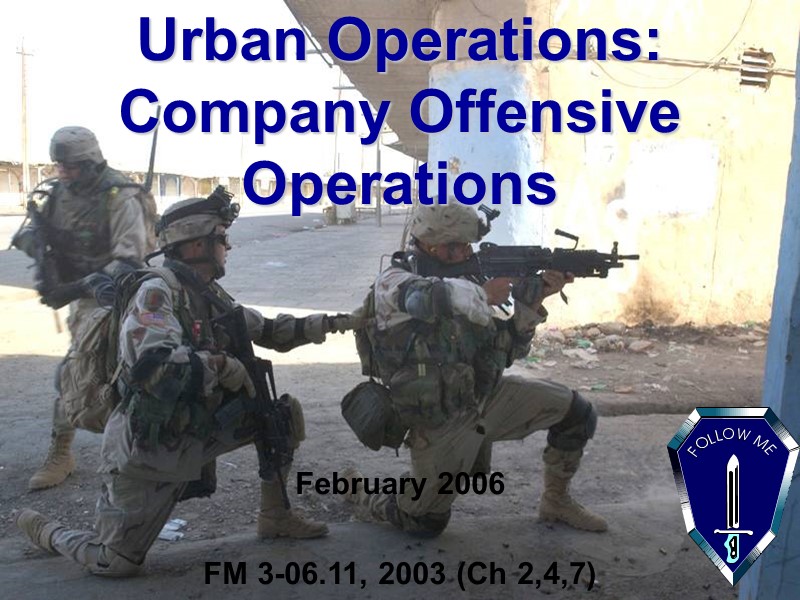
Urban Operations: Company Offensive Operations February 2006 FM 3-06.11, 2003 (Ch 2,4,7)
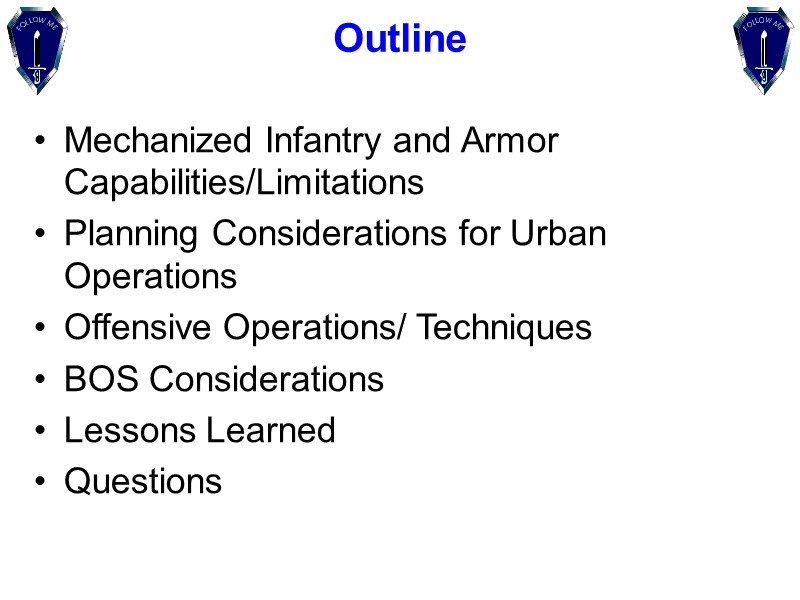
Outline Mechanized Infantry and Armor Capabilities/Limitations Planning Considerations for Urban Operations Offensive Operations/ Techniques BOS Considerations Lessons Learned Questions
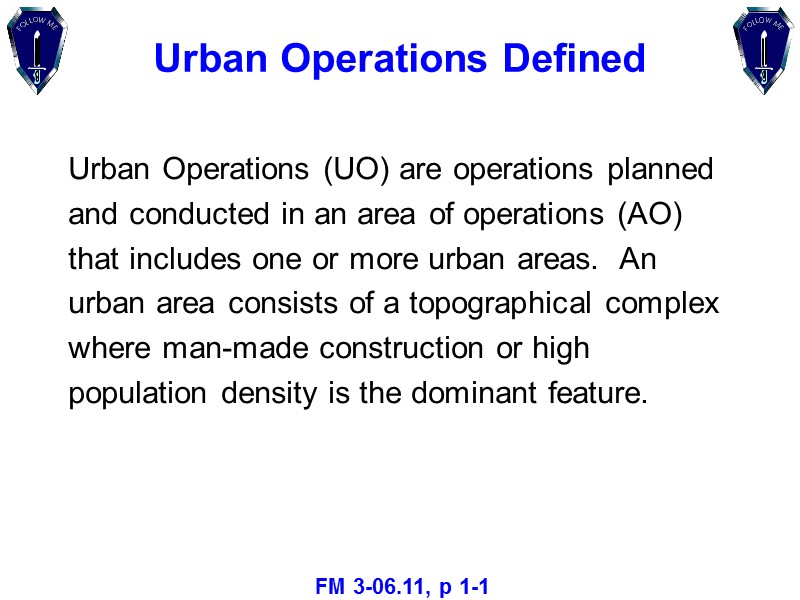
Urban Operations Defined Urban Operations (UO) are operations planned and conducted in an area of operations (AO) that includes one or more urban areas. An urban area consists of a topographical complex where man-made construction or high population density is the dominant feature. FM 3-06.11, p 1-1
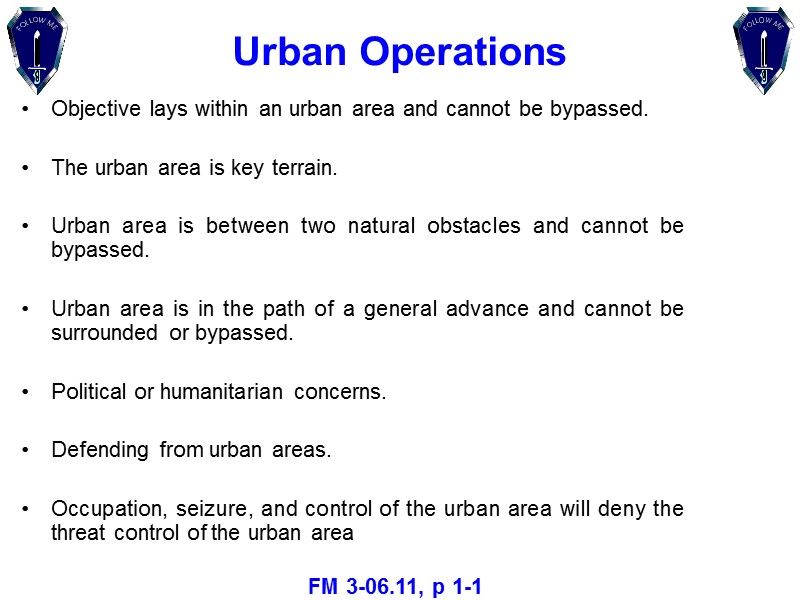
Urban Operations Objective lays within an urban area and cannot be bypassed. The urban area is key terrain. Urban area is between two natural obstacles and cannot be bypassed. Urban area is in the path of a general advance and cannot be surrounded or bypassed. Political or humanitarian concerns. Defending from urban areas. Occupation, seizure, and control of the urban area will deny the threat control of the urban area FM 3-06.11, p 1-1
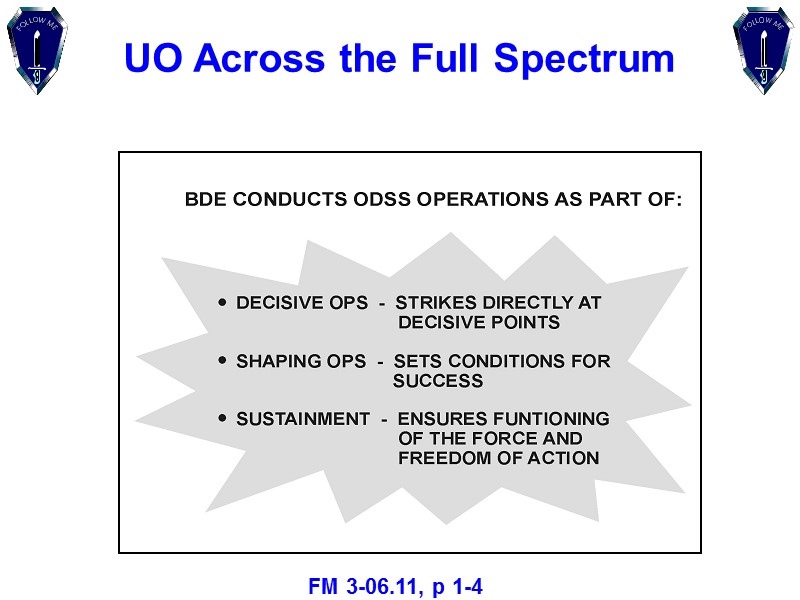
UO Across the Full Spectrum FM 3-06.11, p 1-4
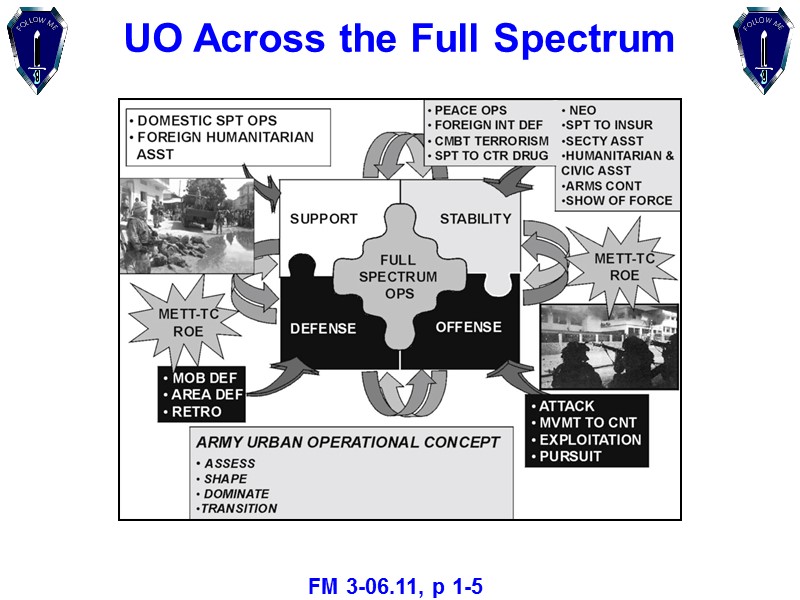
UO Across the Full Spectrum FM 3-06.11, p 1-5
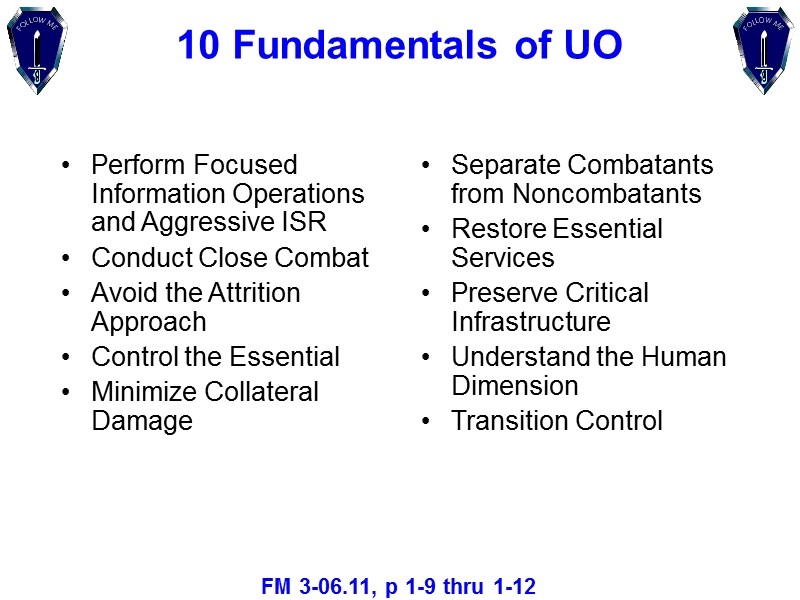
10 Fundamentals of UO Perform Focused Information Operations and Aggressive ISR Conduct Close Combat Avoid the Attrition Approach Control the Essential Minimize Collateral Damage Separate Combatants from Noncombatants Restore Essential Services Preserve Critical Infrastructure Understand the Human Dimension Transition Control FM 3-06.11, p 1-9 thru 1-12
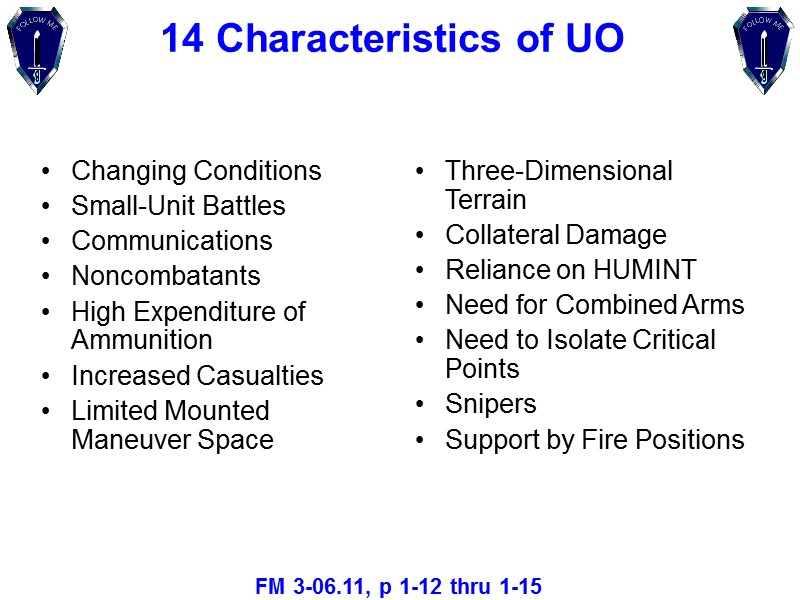
14 Characteristics of UO Changing Conditions Small-Unit Battles Communications Noncombatants High Expenditure of Ammunition Increased Casualties Limited Mounted Maneuver Space Three-Dimensional Terrain Collateral Damage Reliance on HUMINT Need for Combined Arms Need to Isolate Critical Points Snipers Support by Fire Positions FM 3-06.11, p 1-12 thru 1-15
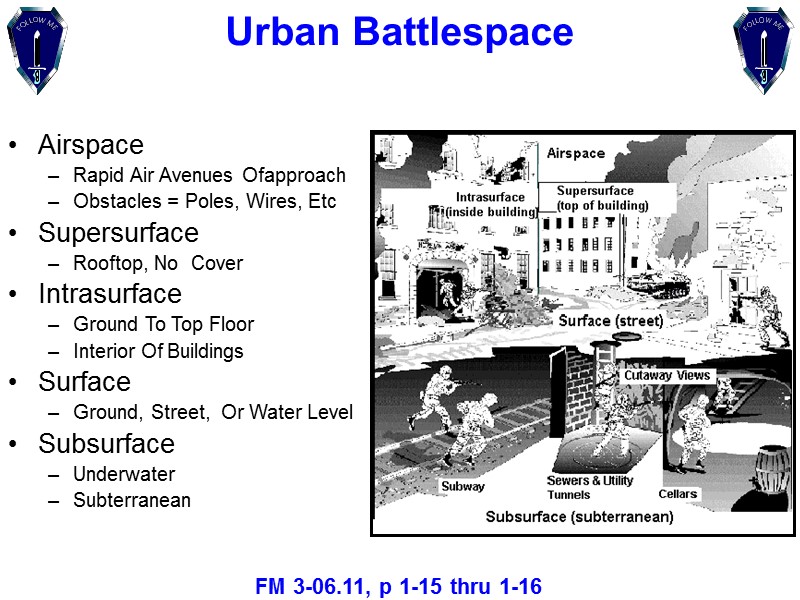
Urban Battlespace Airspace Rapid Air Avenues Ofapproach Obstacles = Poles, Wires, Etc Supersurface Rooftop, No Cover Intrasurface Ground To Top Floor Interior Of Buildings Surface Ground, Street, Or Water Level Subsurface Underwater Subterranean FM 3-06.11, p 1-15 thru 1-16
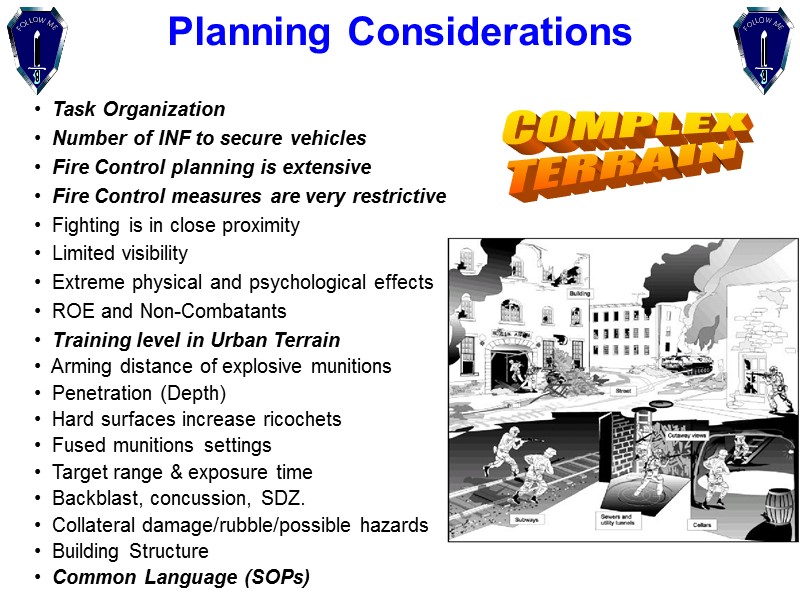
Planning Considerations Task Organization Number of INF to secure vehicles Fire Control planning is extensive Fire Control measures are very restrictive Fighting is in close proximity Limited visibility Extreme physical and psychological effects ROE and Non-Combatants Training level in Urban Terrain Arming distance of explosive munitions Penetration (Depth) Hard surfaces increase ricochets Fused munitions settings Target range & exposure time Backblast, concussion, SDZ. Collateral damage/rubble/possible hazards Building Structure Common Language (SOPs) COMPLEX TERRAIN
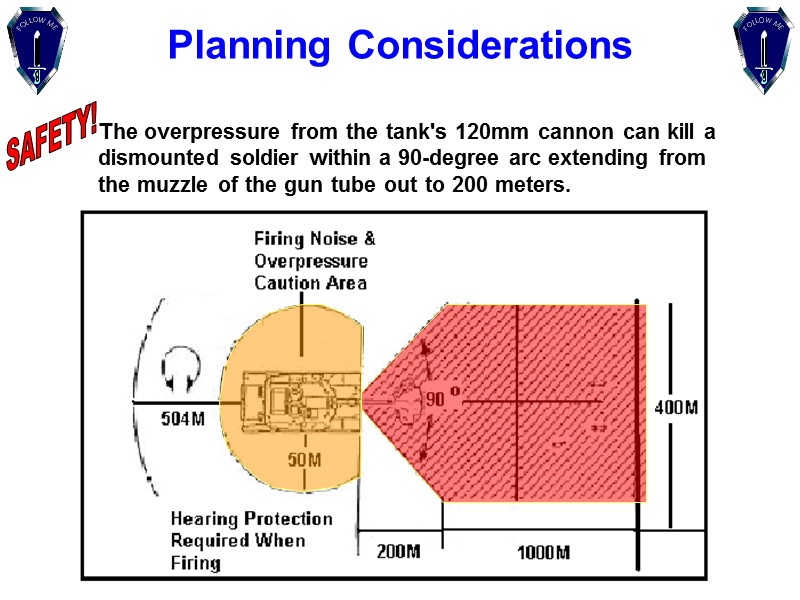
The overpressure from the tank's 120mm cannon can kill a dismounted soldier within a 90-degree arc extending from the muzzle of the gun tube out to 200 meters. SAFETY! Planning Considerations
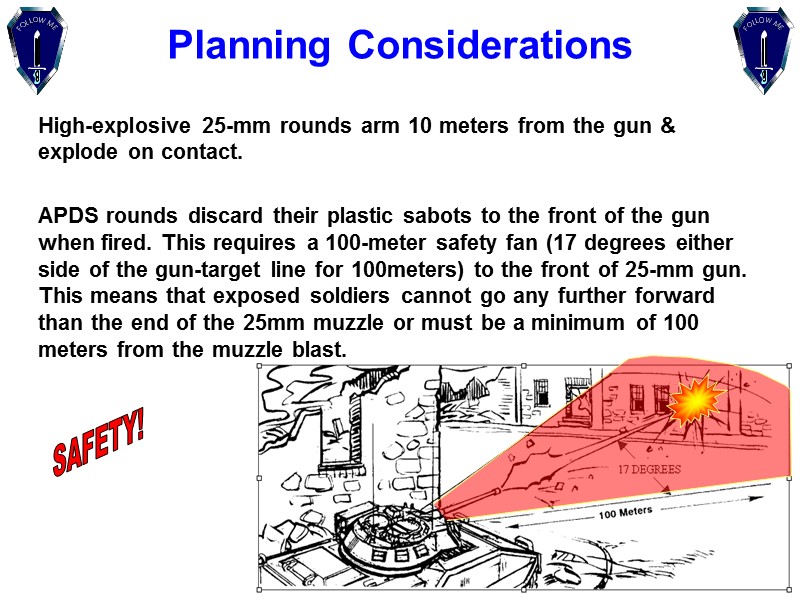
High-explosive 25-mm rounds arm 10 meters from the gun & explode on contact. APDS rounds discard their plastic sabots to the front of the gun when fired. This requires a 100-meter safety fan (17 degrees either side of the gun-target line for 100meters) to the front of 25-mm gun. This means that exposed soldiers cannot go any further forward than the end of the 25mm muzzle or must be a minimum of 100 meters from the muzzle blast. SAFETY! Planning Considerations
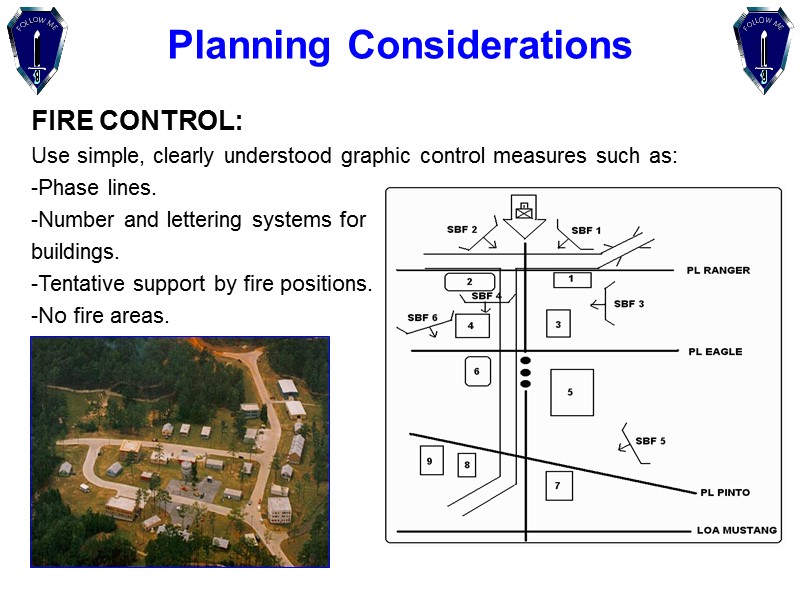
FIRE CONTROL: Use simple, clearly understood graphic control measures such as: -Phase lines. -Number and lettering systems for buildings. -Tentative support by fire positions. -No fire areas. Planning Considerations
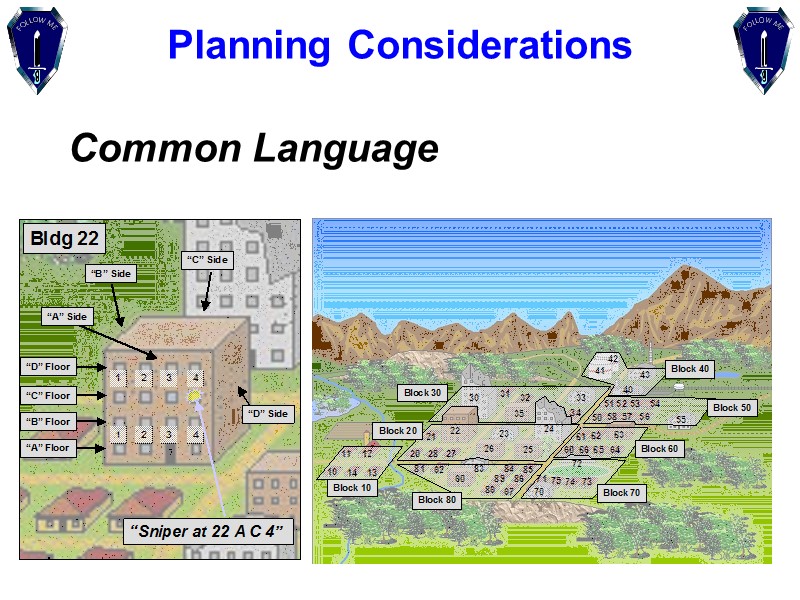
Common Language Planning Considerations
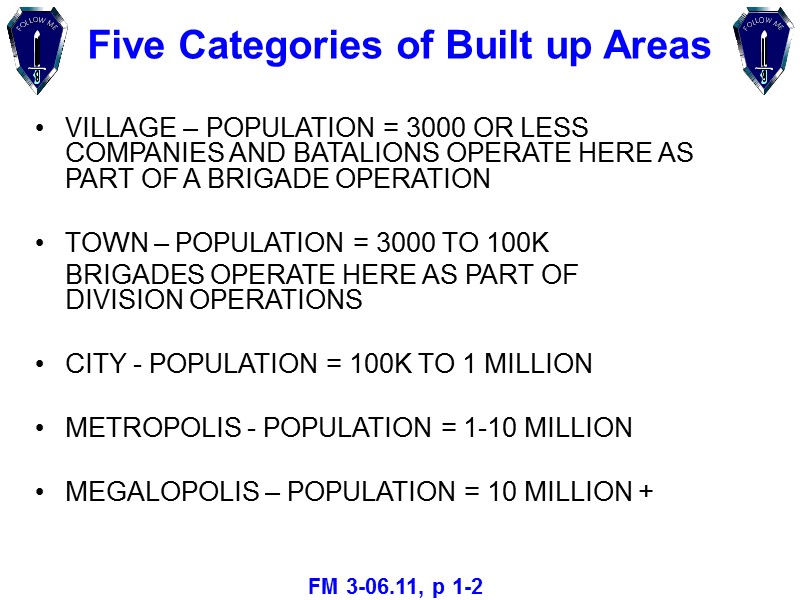
Five Categories of Built up Areas VILLAGE – POPULATION = 3000 OR LESS COMPANIES AND BATALIONS OPERATE HERE AS PART OF A BRIGADE OPERATION TOWN – POPULATION = 3000 TO 100K BRIGADES OPERATE HERE AS PART OF DIVISION OPERATIONS CITY - POPULATION = 100K TO 1 MILLION METROPOLIS - POPULATION = 1-10 MILLION MEGALOPOLIS – POPULATION = 10 MILLION + FM 3-06.11, p 1-2
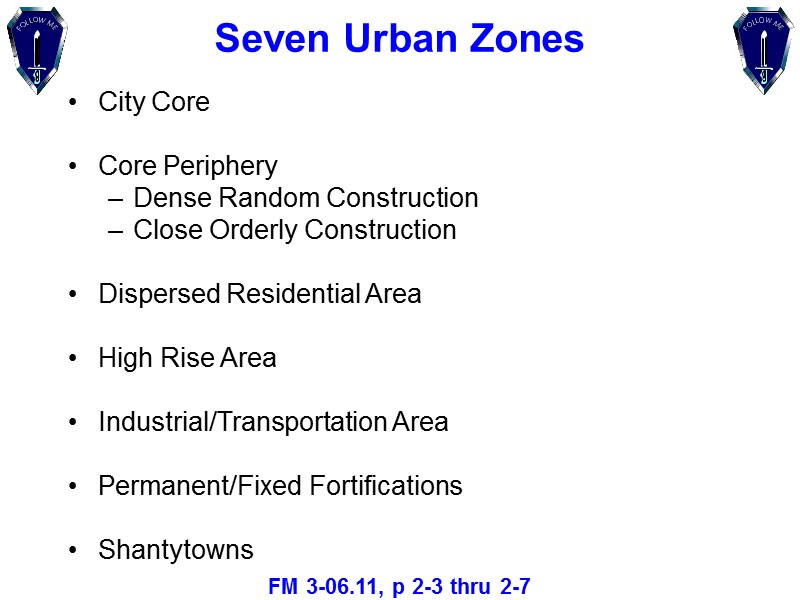
Seven Urban Zones City Core Core Periphery Dense Random Construction Close Orderly Construction Dispersed Residential Area High Rise Area Industrial/Transportation Area Permanent/Fixed Fortifications Shantytowns FM 3-06.11, p 2-3 thru 2-7
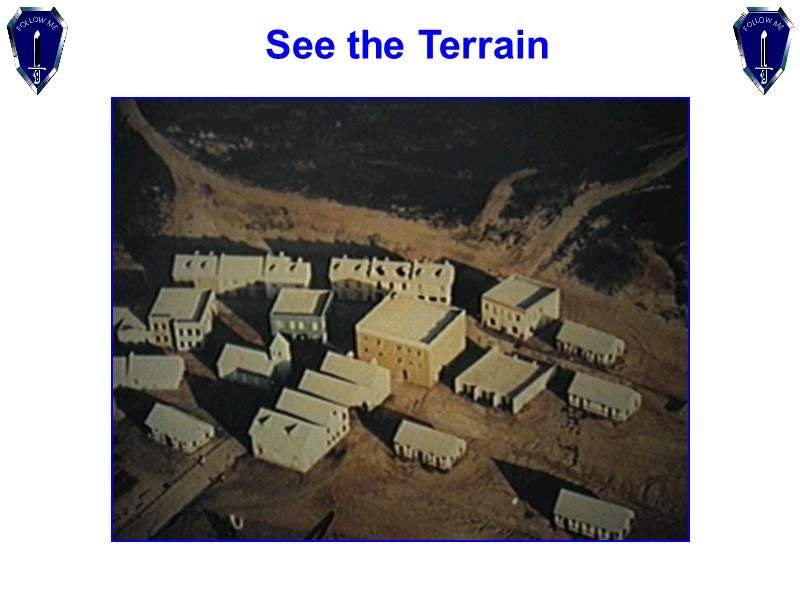
See the Terrain
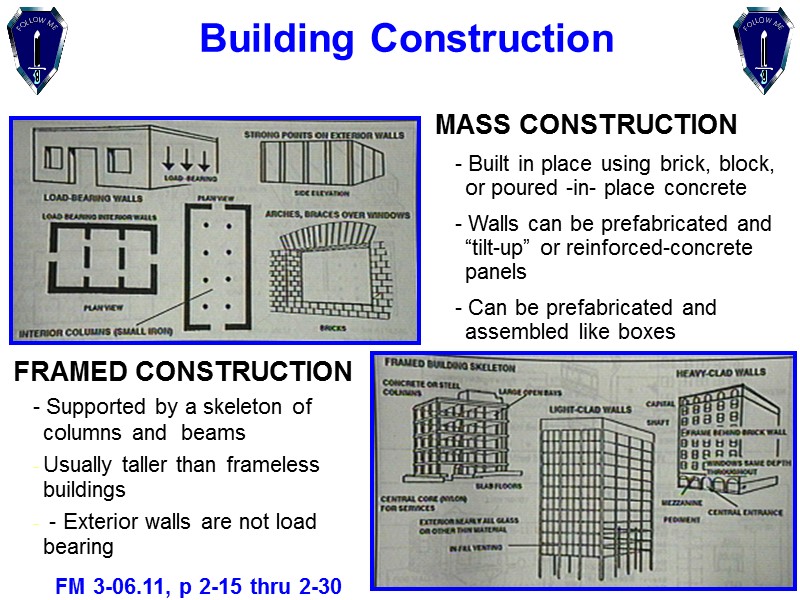
MASS CONSTRUCTION - Built in place using brick, block, or poured -in- place concrete - Walls can be prefabricated and “tilt-up” or reinforced-concrete panels - Can be prefabricated and assembled like boxes FRAMED CONSTRUCTION - Supported by a skeleton of columns and beams Usually taller than frameless buildings - Exterior walls are not load bearing Building Construction FM 3-06.11, p 2-15 thru 2-30
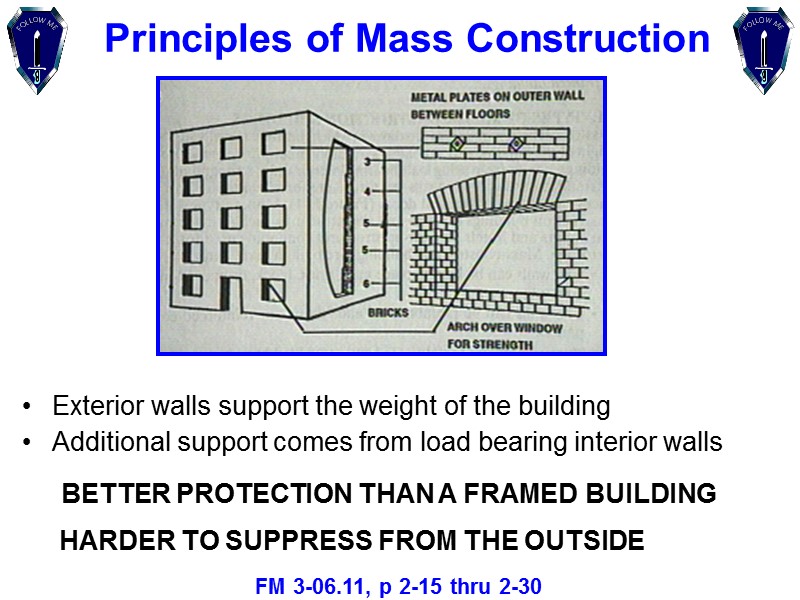
Exterior walls support the weight of the building Additional support comes from load bearing interior walls BETTER PROTECTION THAN A FRAMED BUILDING HARDER TO SUPPRESS FROM THE OUTSIDE Principles of Mass Construction FM 3-06.11, p 2-15 thru 2-30
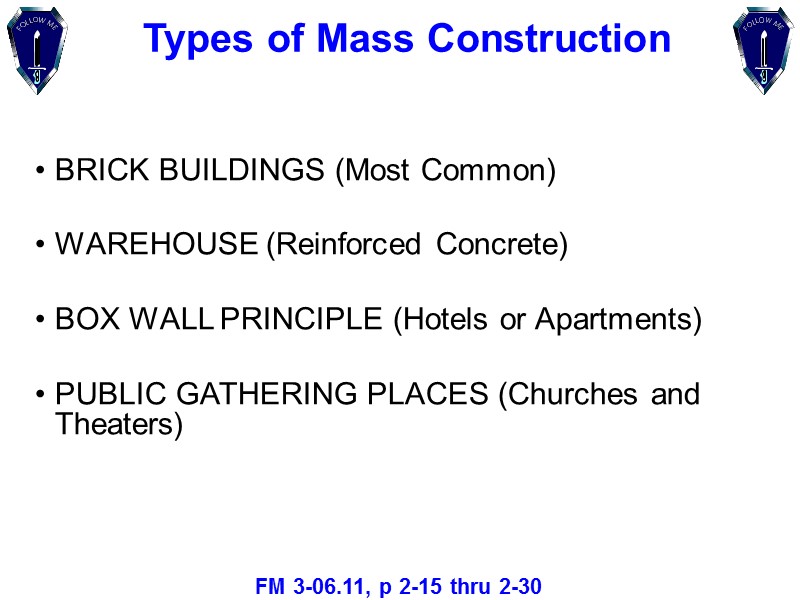
BRICK BUILDINGS (Most Common) WAREHOUSE (Reinforced Concrete) BOX WALL PRINCIPLE (Hotels or Apartments) PUBLIC GATHERING PLACES (Churches and Theaters) Types of Mass Construction FM 3-06.11, p 2-15 thru 2-30
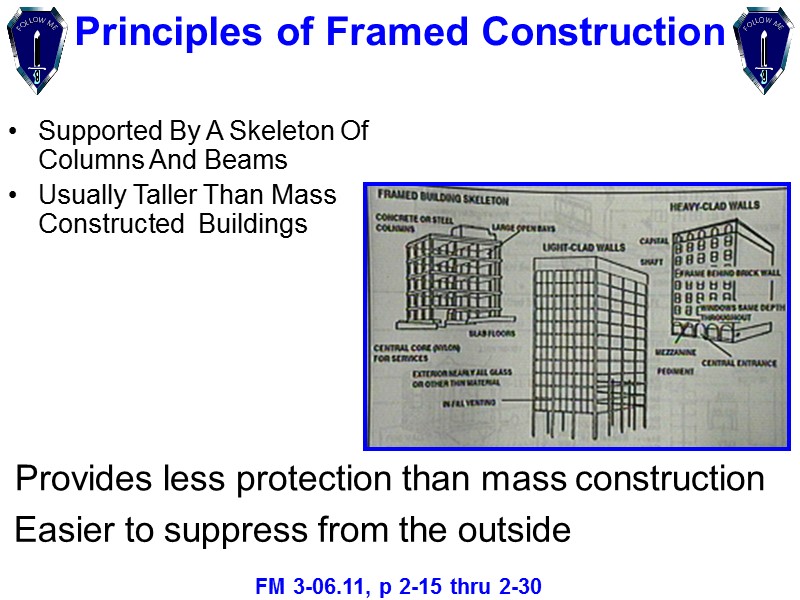
Supported By A Skeleton Of Columns And Beams Usually Taller Than Mass Constructed Buildings Provides less protection than mass construction Easier to suppress from the outside Principles of Framed Construction FM 3-06.11, p 2-15 thru 2-30
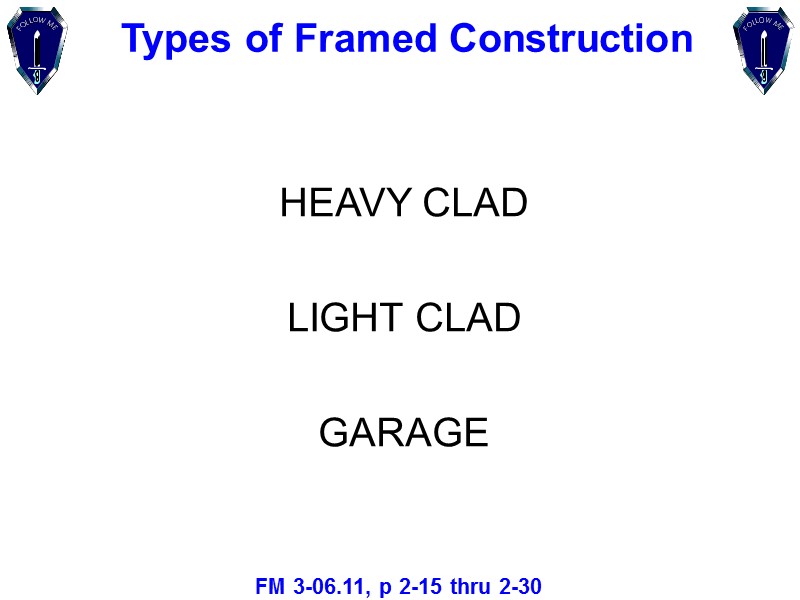
HEAVY CLAD LIGHT CLAD GARAGE Types of Framed Construction FM 3-06.11, p 2-15 thru 2-30
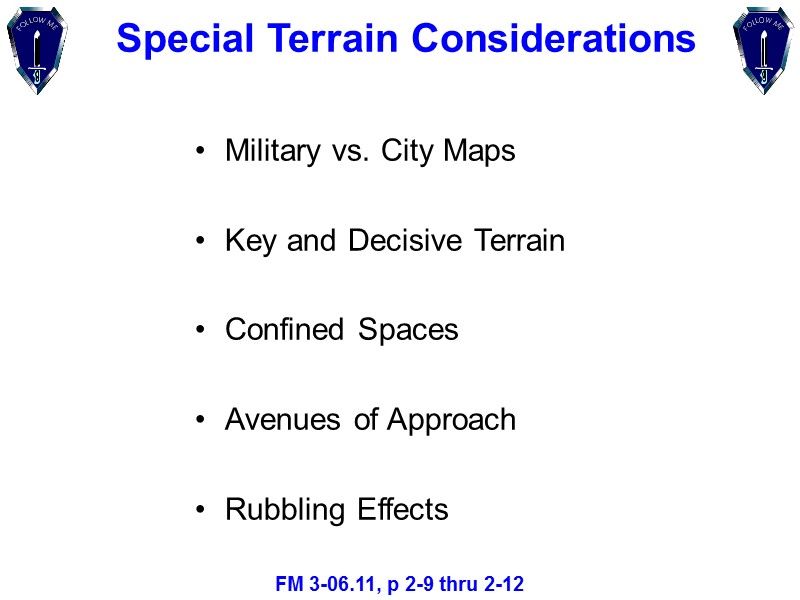
Military vs. City Maps Key and Decisive Terrain Confined Spaces Avenues of Approach Rubbling Effects Special Terrain Considerations FM 3-06.11, p 2-9 thru 2-12
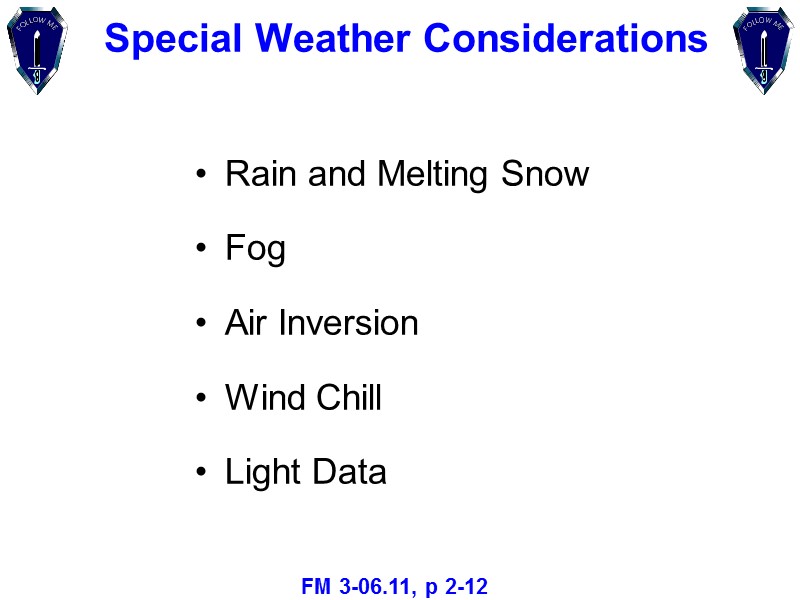
Rain and Melting Snow Fog Air Inversion Wind Chill Light Data Special Weather Considerations FM 3-06.11, p 2-12
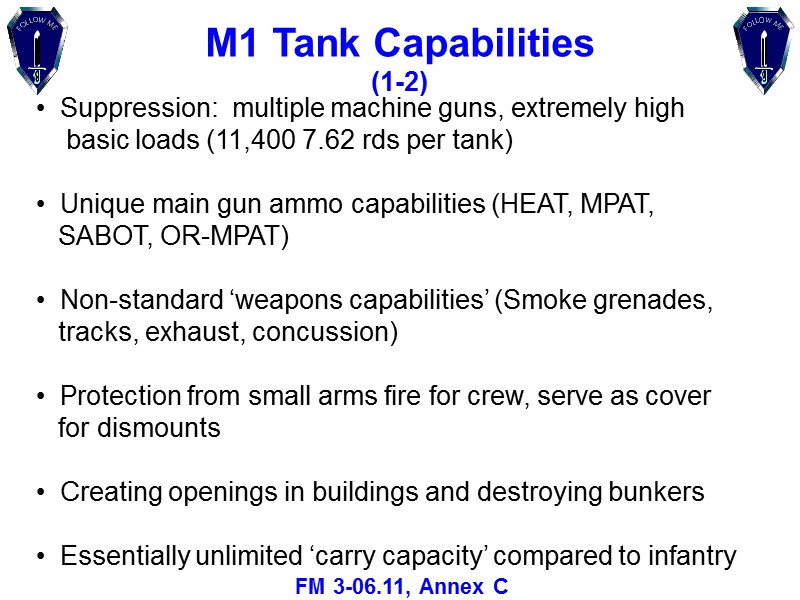
Suppression: multiple machine guns, extremely high basic loads (11,400 7.62 rds per tank) Unique main gun ammo capabilities (HEAT, MPAT, SABOT, OR-MPAT) Non-standard ‘weapons capabilities’ (Smoke grenades, tracks, exhaust, concussion) Protection from small arms fire for crew, serve as cover for dismounts Creating openings in buildings and destroying bunkers Essentially unlimited ‘carry capacity’ compared to infantry M1 Tank Capabilities (1-2) FM 3-06.11, Annex C
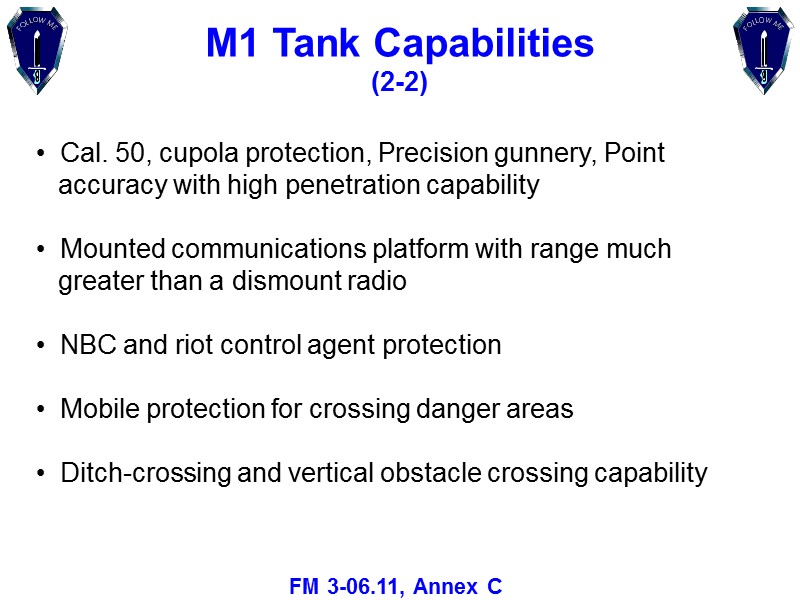
Cal. 50, cupola protection, Precision gunnery, Point accuracy with high penetration capability Mounted communications platform with range much greater than a dismount radio NBC and riot control agent protection Mobile protection for crossing danger areas Ditch-crossing and vertical obstacle crossing capability M1 Tank Capabilities (2-2) FM 3-06.11, Annex C
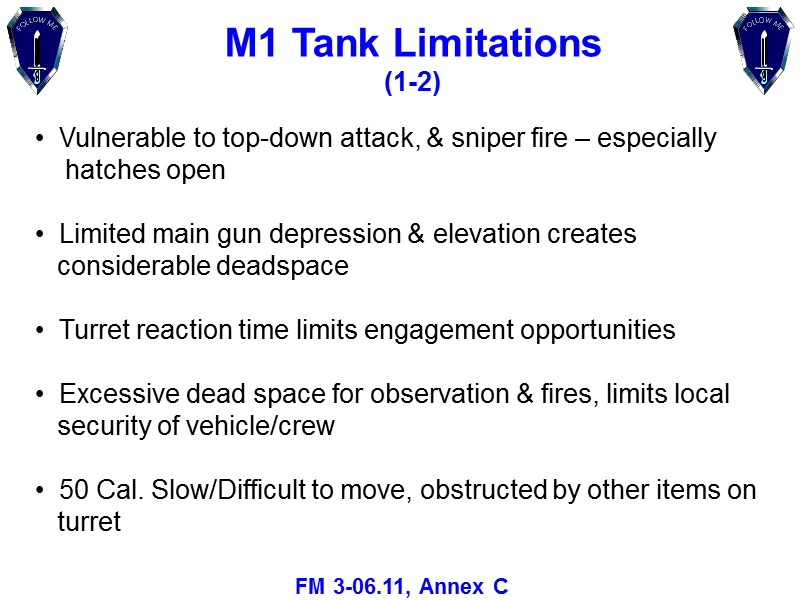
Vulnerable to top-down attack, & sniper fire – especially hatches open Limited main gun depression & elevation creates considerable deadspace Turret reaction time limits engagement opportunities Excessive dead space for observation & fires, limits local security of vehicle/crew 50 Cal. Slow/Difficult to move, obstructed by other items on turret M1 Tank Limitations (1-2) FM 3-06.11, Annex C
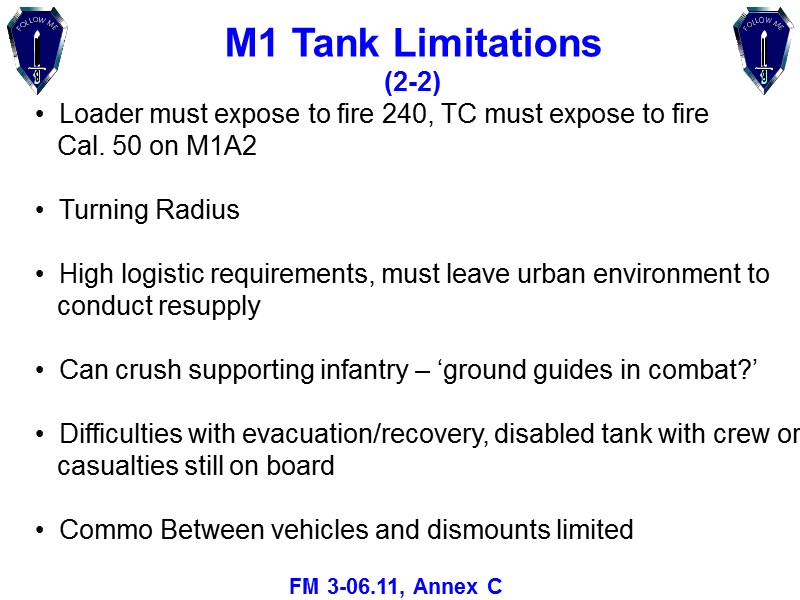
Loader must expose to fire 240, TC must expose to fire Cal. 50 on M1A2 Turning Radius High logistic requirements, must leave urban environment to conduct resupply Can crush supporting infantry – ‘ground guides in combat?’ Difficulties with evacuation/recovery, disabled tank with crew or casualties still on board Commo Between vehicles and dismounts limited M1 Tank Limitations (2-2) FM 3-06.11, Annex C
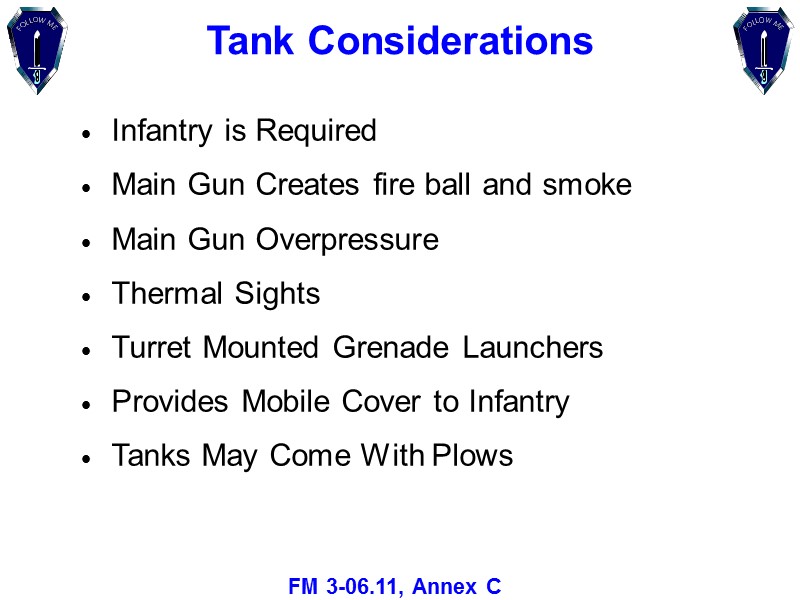
Tank Considerations Infantry is Required Main Gun Creates fire ball and smoke Main Gun Overpressure Thermal Sights Turret Mounted Grenade Launchers Provides Mobile Cover to Infantry Tanks May Come With Plows FM 3-06.11, Annex C
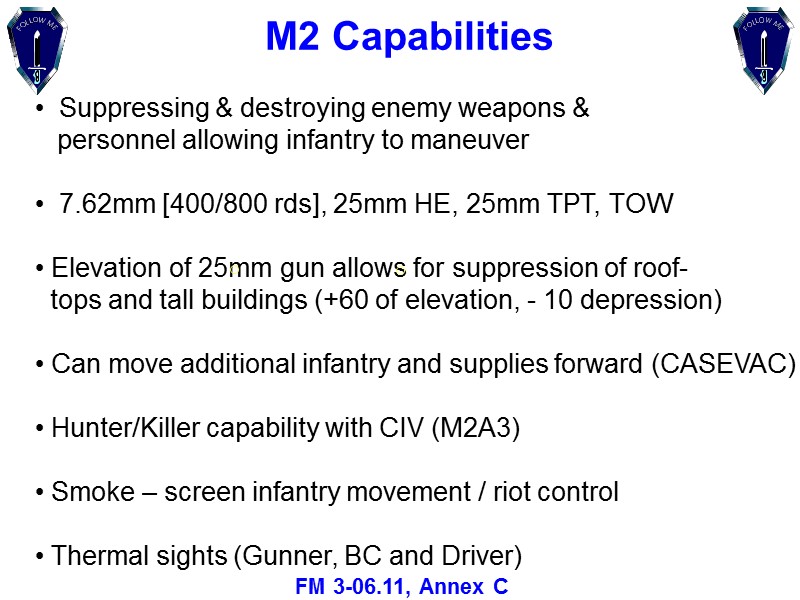
Suppressing & destroying enemy weapons & personnel allowing infantry to maneuver 7.62mm [400/800 rds], 25mm HE, 25mm TPT, TOW Elevation of 25mm gun allows for suppression of roof- tops and tall buildings (+60 of elevation, - 10 depression) Can move additional infantry and supplies forward (CASEVAC) Hunter/Killer capability with CIV (M2A3) Smoke – screen infantry movement / riot control Thermal sights (Gunner, BC and Driver) M2 Capabilities FM 3-06.11, Annex C
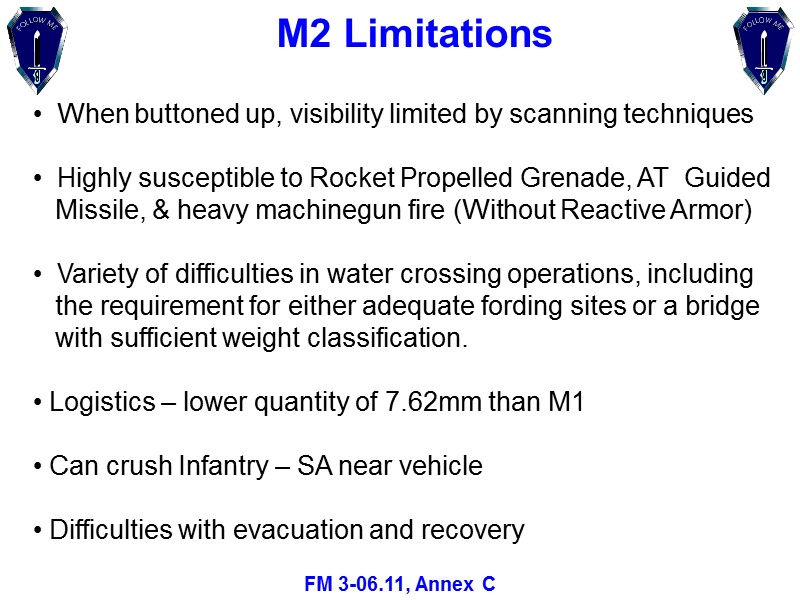
When buttoned up, visibility limited by scanning techniques Highly susceptible to Rocket Propelled Grenade, AT Guided Missile, & heavy machinegun fire (Without Reactive Armor) Variety of difficulties in water crossing operations, including the requirement for either adequate fording sites or a bridge with sufficient weight classification. Logistics – lower quantity of 7.62mm than M1 Can crush Infantry – SA near vehicle Difficulties with evacuation and recovery M2 Limitations FM 3-06.11, Annex C
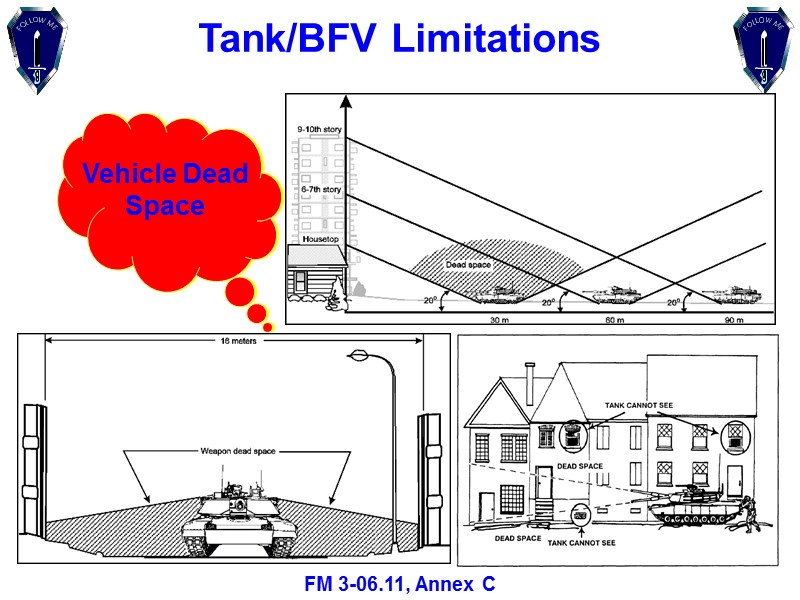
Tank/BFV Limitations Vehicle Dead Space FM 3-06.11, Annex C
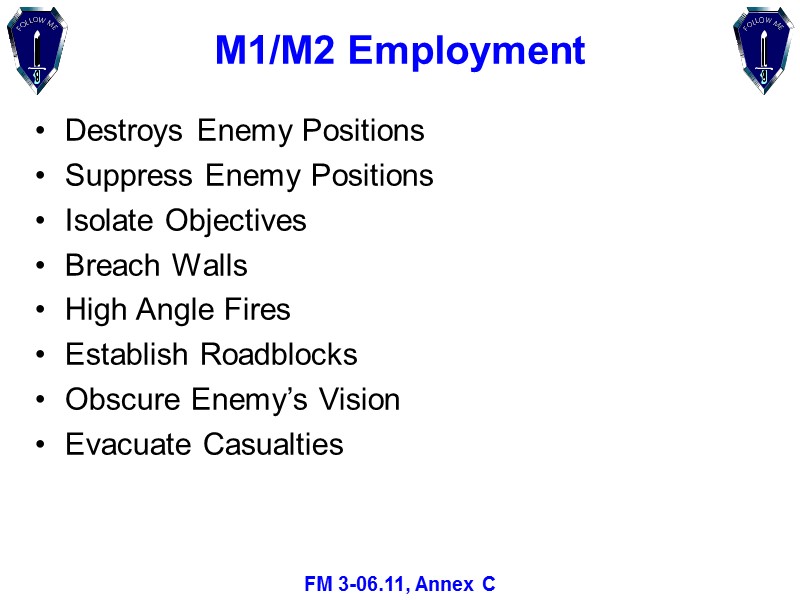
M1/M2 Employment Destroys Enemy Positions Suppress Enemy Positions Isolate Objectives Breach Walls High Angle Fires Establish Roadblocks Obscure Enemy’s Vision Evacuate Casualties FM 3-06.11, Annex C
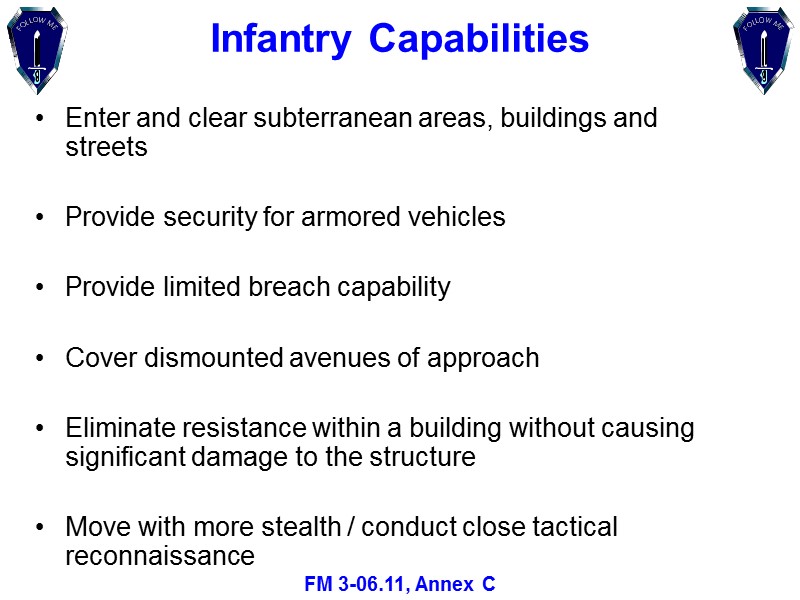
Infantry Capabilities Enter and clear subterranean areas, buildings and streets Provide security for armored vehicles Provide limited breach capability Cover dismounted avenues of approach Eliminate resistance within a building without causing significant damage to the structure Move with more stealth / conduct close tactical reconnaissance Infantrymen have excellent all-round vision and can engage targets with small arms fire under almost all conditions. FM 3-06.11, Annex C
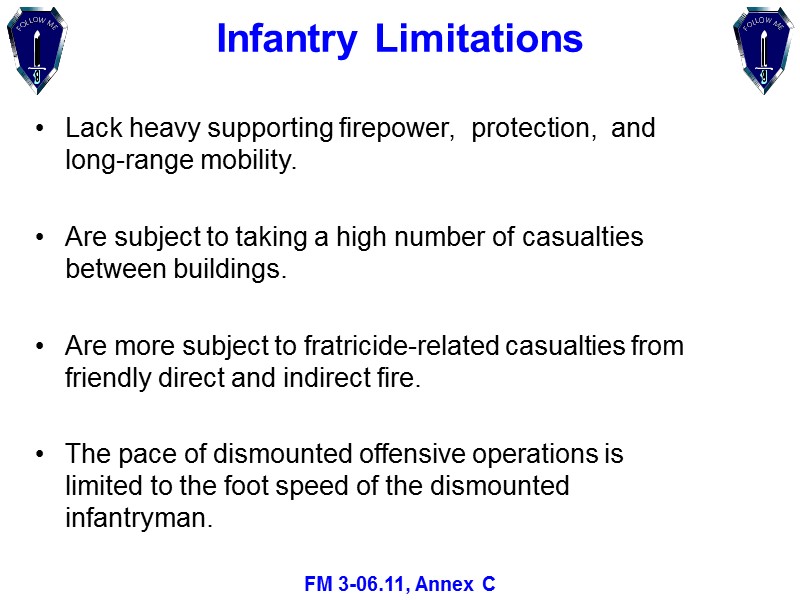
Lack heavy supporting firepower, protection, and long-range mobility. Are subject to taking a high number of casualties between buildings. Are more subject to fratricide-related casualties from friendly direct and indirect fire. The pace of dismounted offensive operations is limited to the foot speed of the dismounted infantryman. Infantry Limitations FM 3-06.11, Annex C
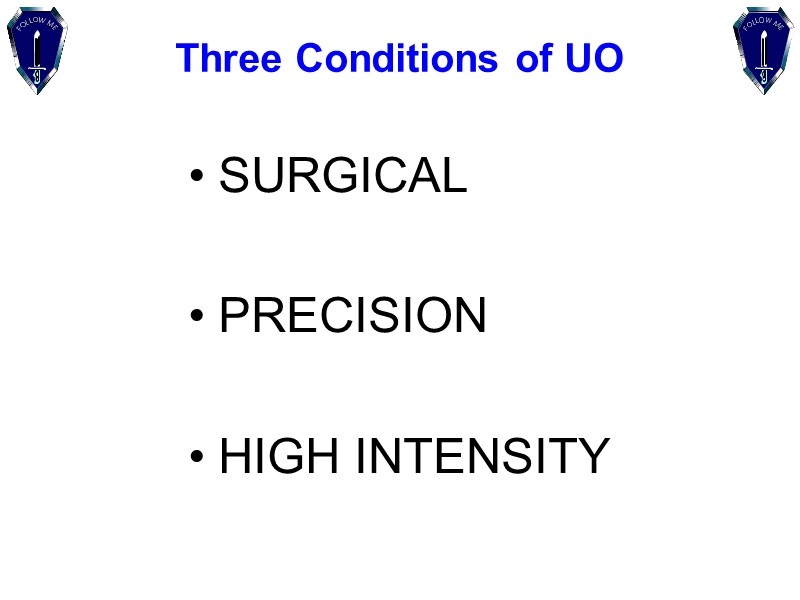
Three Conditions of UO SURGICAL PRECISION HIGH INTENSITY
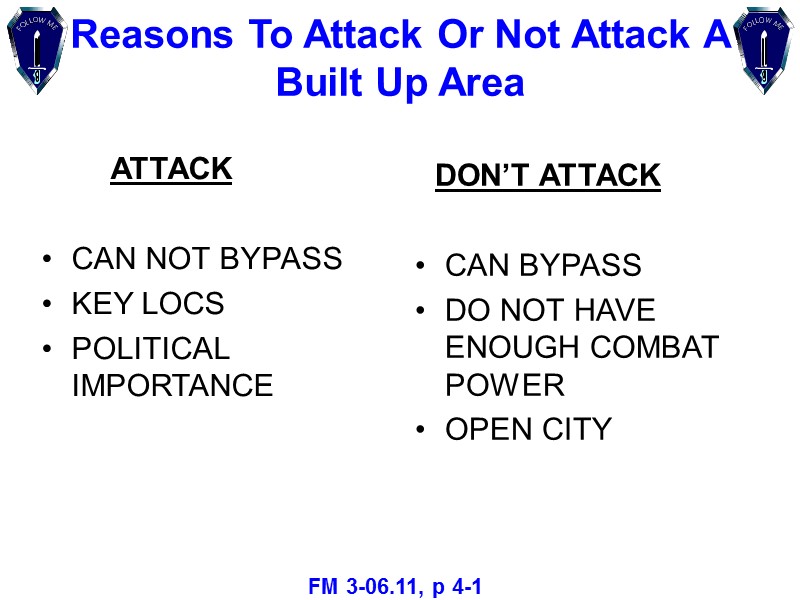
DON’T ATTACK CAN BYPASS DO NOT HAVE ENOUGH COMBAT POWER OPEN CITY Reasons To Attack Or Not Attack A Built Up Area ATTACK CAN NOT BYPASS KEY LOCS POLITICAL IMPORTANCE FM 3-06.11, p 4-1
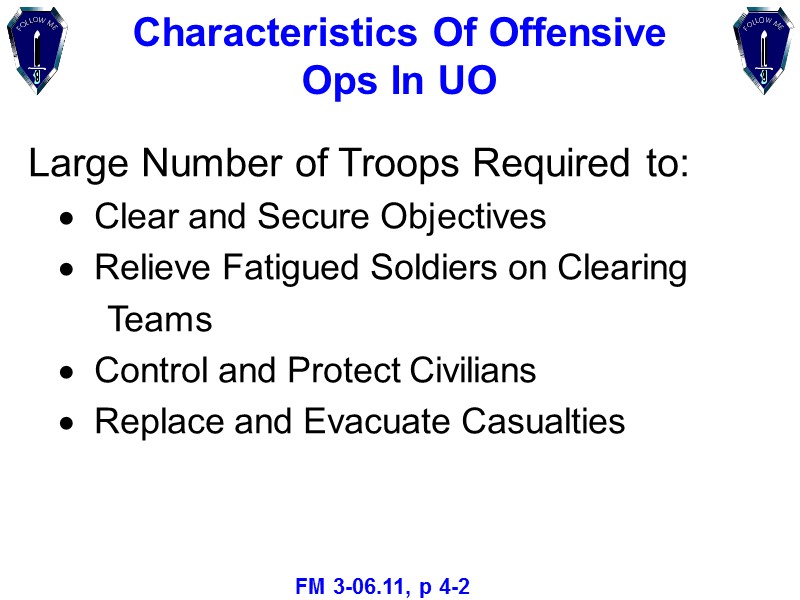
Characteristics Of Offensive Ops In UO Large Number of Troops Required to: Clear and Secure Objectives Relieve Fatigued Soldiers on Clearing Teams Control and Protect Civilians Replace and Evacuate Casualties FM 3-06.11, p 4-2
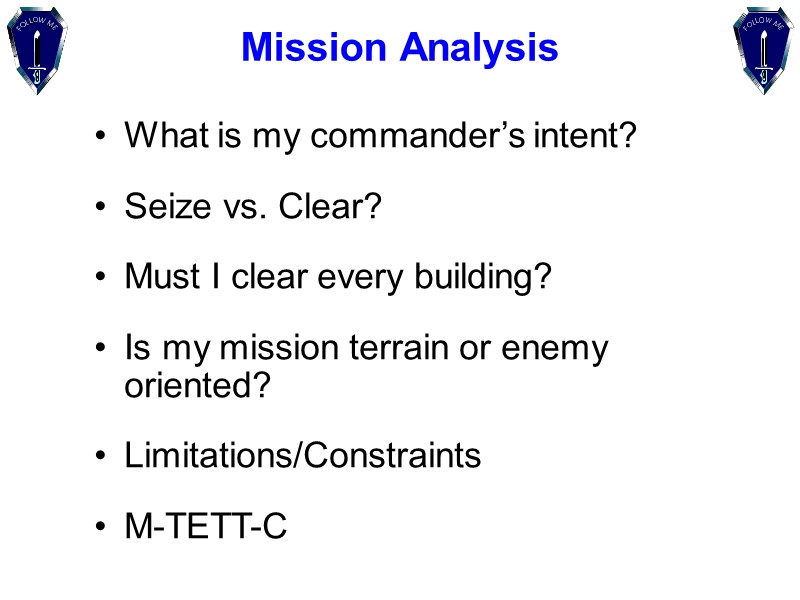
Mission Analysis What is my commander’s intent? Seize vs. Clear? Must I clear every building? Is my mission terrain or enemy oriented? Limitations/Constraints M-TETT-C
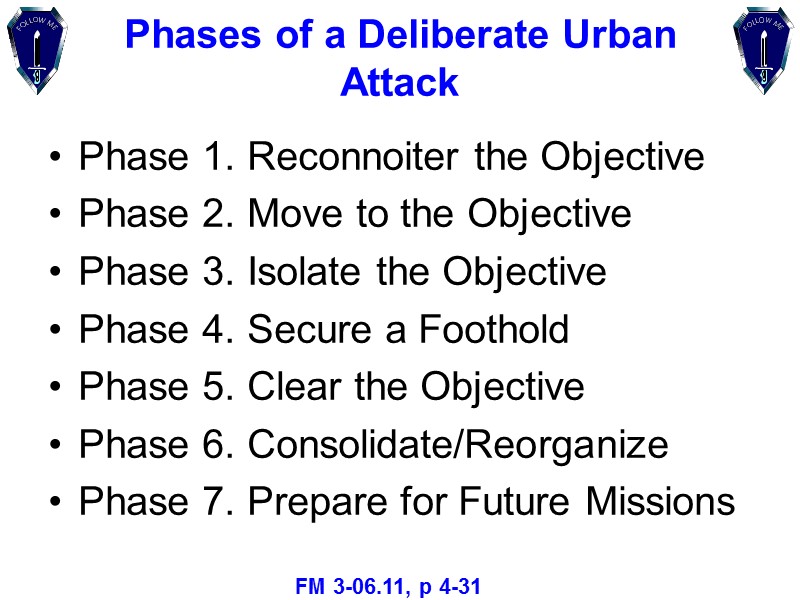
Phases of a Deliberate Urban Attack Phase 1. Reconnoiter the Objective Phase 2. Move to the Objective Phase 3. Isolate the Objective Phase 4. Secure a Foothold Phase 5. Clear the Objective Phase 6. Consolidate/Reorganize Phase 7. Prepare for Future Missions FM 3-06.11, p 4-31
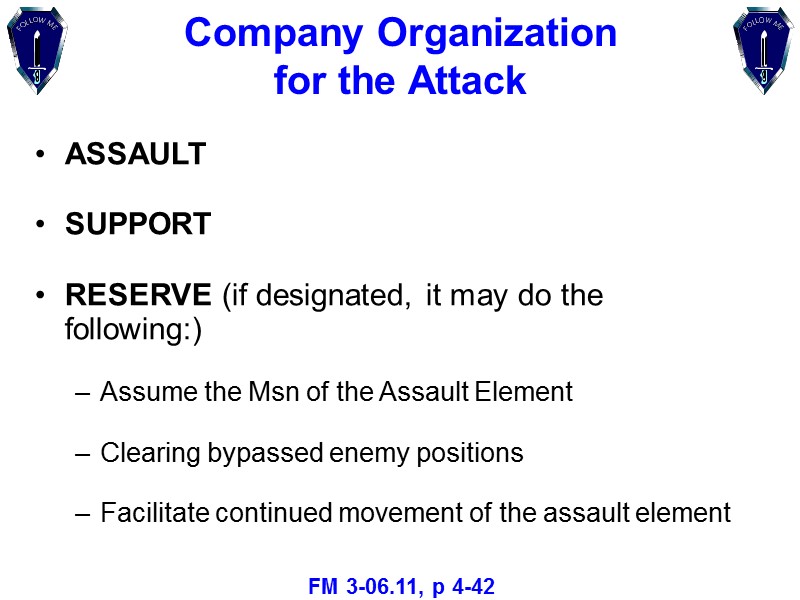
Company Organization for the Attack ASSAULT SUPPORT RESERVE (if designated, it may do the following:) Assume the Msn of the Assault Element Clearing bypassed enemy positions Facilitate continued movement of the assault element FM 3-06.11, p 4-42
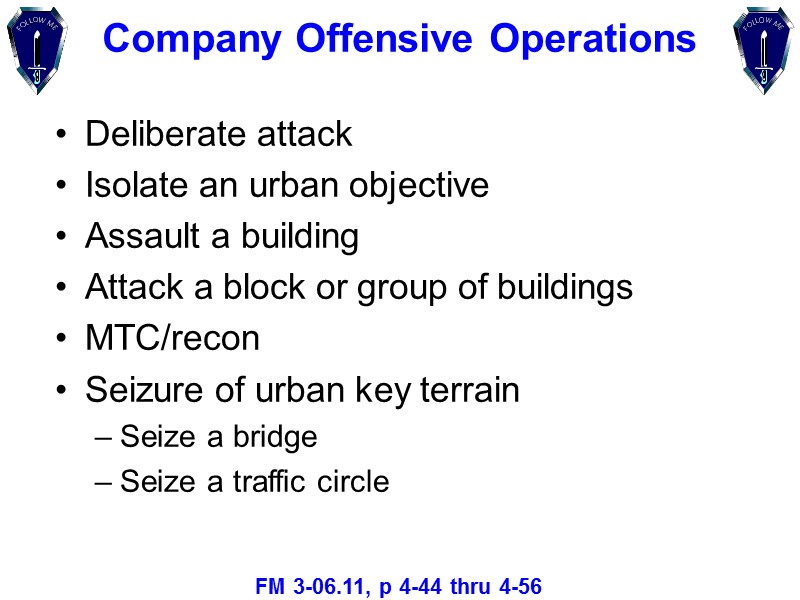
Company Offensive Operations Deliberate attack Isolate an urban objective Assault a building Attack a block or group of buildings MTC/recon Seizure of urban key terrain Seize a bridge Seize a traffic circle FM 3-06.11, p 4-44 thru 4-56
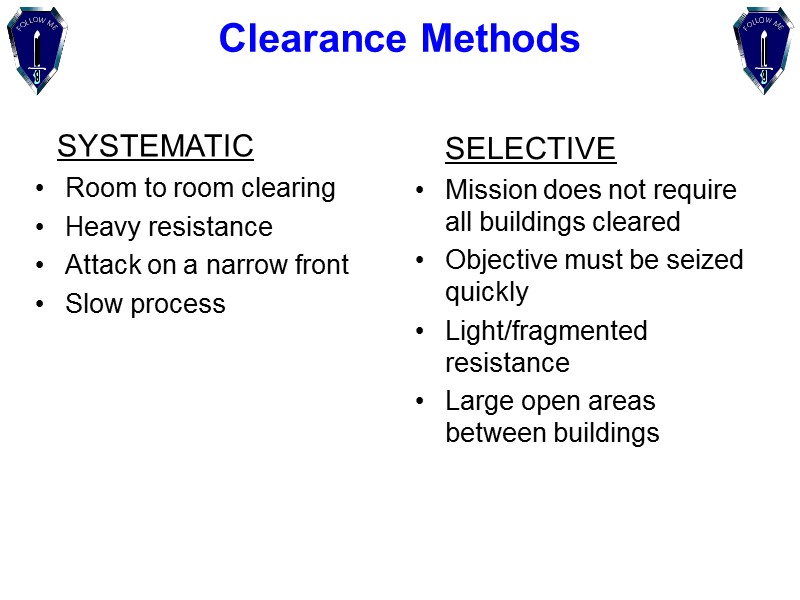
Clearance Methods SYSTEMATIC Room to room clearing Heavy resistance Attack on a narrow front Slow process SELECTIVE Mission does not require all buildings cleared Objective must be seized quickly Light/fragmented resistance Large open areas between buildings
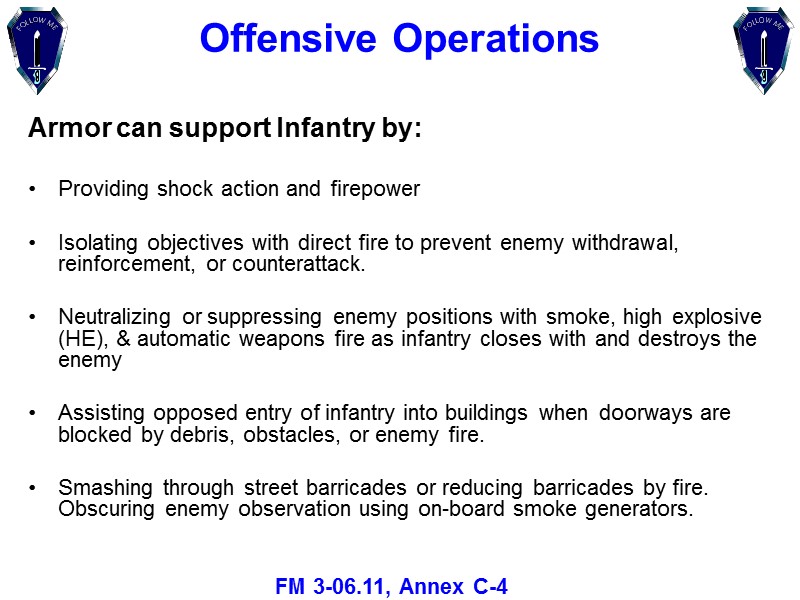
Armor can support Infantry by: Providing shock action and firepower Isolating objectives with direct fire to prevent enemy withdrawal, reinforcement, or counterattack. Neutralizing or suppressing enemy positions with smoke, high explosive (HE), & automatic weapons fire as infantry closes with and destroys the enemy Assisting opposed entry of infantry into buildings when doorways are blocked by debris, obstacles, or enemy fire. Smashing through street barricades or reducing barricades by fire. Obscuring enemy observation using on-board smoke generators. Offensive Operations FM 3-06.11, Annex C-4
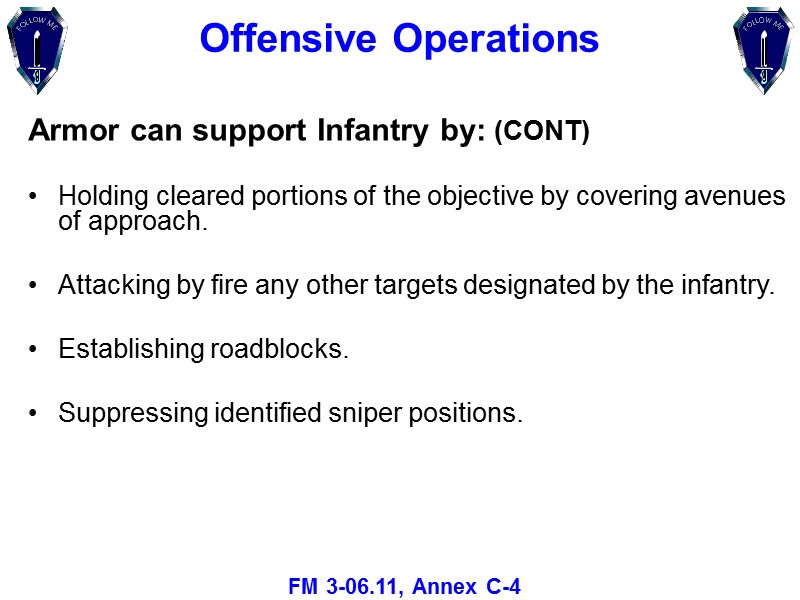
Armor can support Infantry by: (CONT) Holding cleared portions of the objective by covering avenues of approach. Attacking by fire any other targets designated by the infantry. Establishing roadblocks. Suppressing identified sniper positions. Offensive Operations FM 3-06.11, Annex C-4
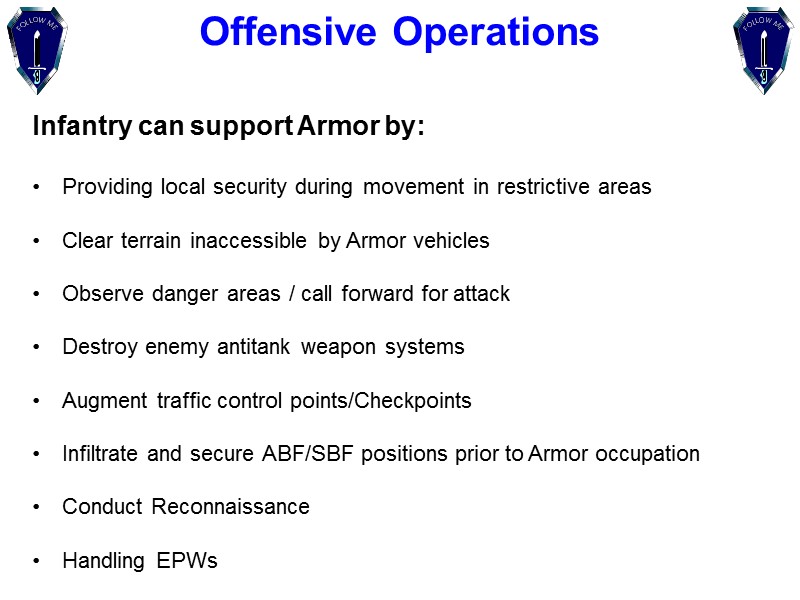
Offensive Operations Infantry can support Armor by: Providing local security during movement in restrictive areas Clear terrain inaccessible by Armor vehicles Observe danger areas / call forward for attack Destroy enemy antitank weapon systems Augment traffic control points/Checkpoints Infiltrate and secure ABF/SBF positions prior to Armor occupation Conduct Reconnaissance Handling EPWs
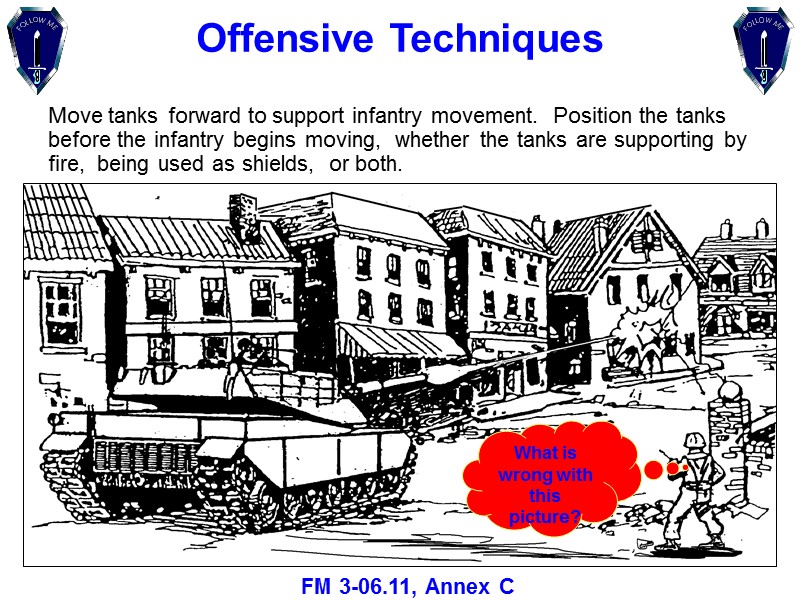
Offensive Techniques Move tanks forward to support infantry movement. Position the tanks before the infantry begins moving, whether the tanks are supporting by fire, being used as shields, or both. What is wrong with this picture? FM 3-06.11, Annex C
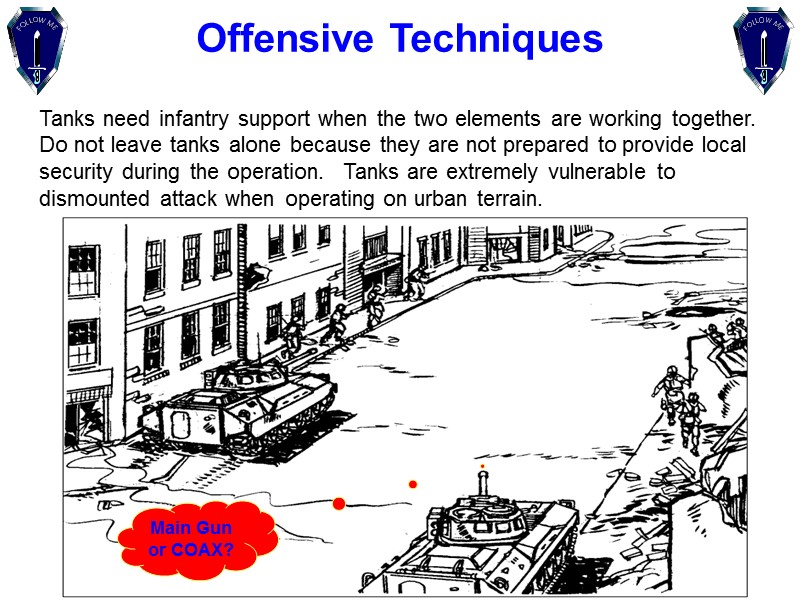
Offensive Techniques Tanks need infantry support when the two elements are working together. Do not leave tanks alone because they are not prepared to provide local security during the operation. Tanks are extremely vulnerable to dismounted attack when operating on urban terrain. Main Gun or COAX?
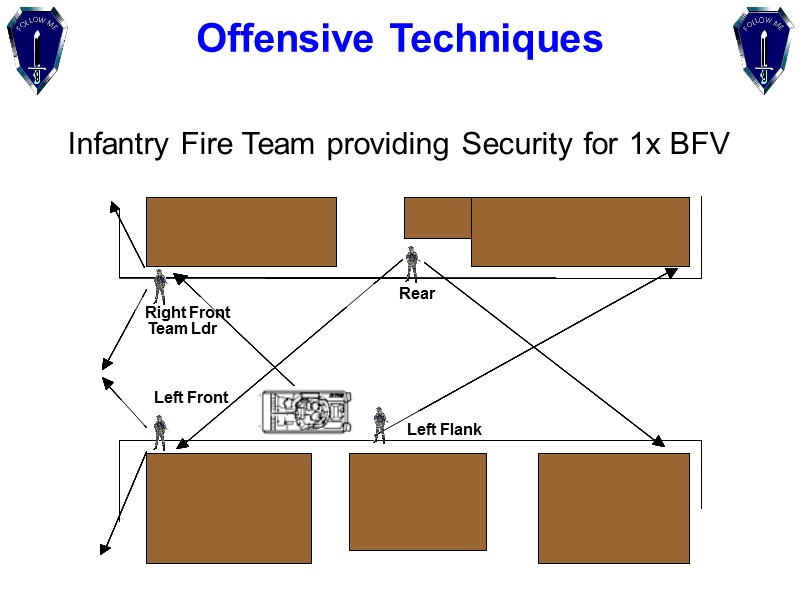
Team Ldr Rear Left Flank Right Front Left Front Team Ldr Rear Left Flank Right Front Left Front Team Ldr Rear Left Flank Right Front Left Front Team Ldr Rear Left Flank Right Front Left Front Team Ldr Rear Left Flank Right Front Left Front Team Ldr Rear Left Flank Right Front Left Front Infantry Fire Team providing Security for 1x BFV Offensive Techniques
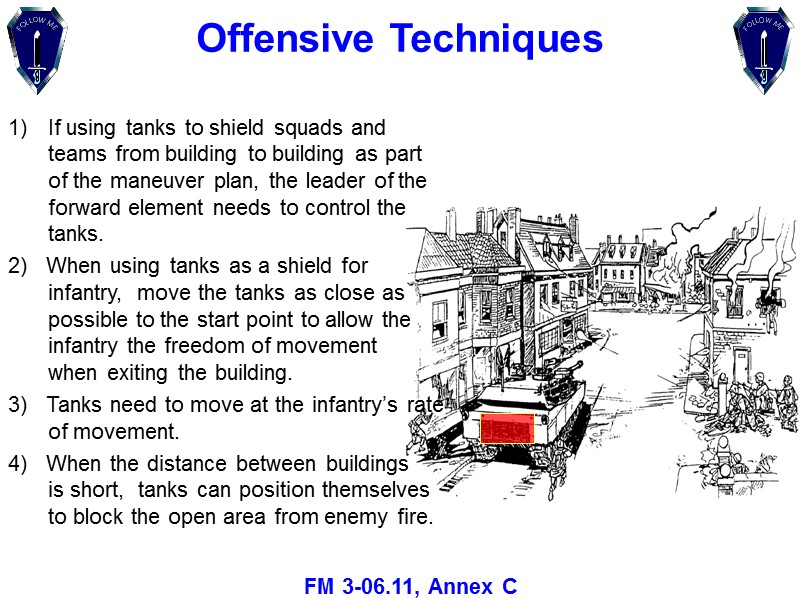
If using tanks to shield squads and teams from building to building as part of the maneuver plan, the leader of the forward element needs to control the tanks. 2) When using tanks as a shield for infantry, move the tanks as close as possible to the start point to allow the infantry the freedom of movement when exiting the building. 3) Tanks need to move at the infantry’s rate of movement. 4) When the distance between buildings is short, tanks can position themselves to block the open area from enemy fire. Offensive Techniques FM 3-06.11, Annex C
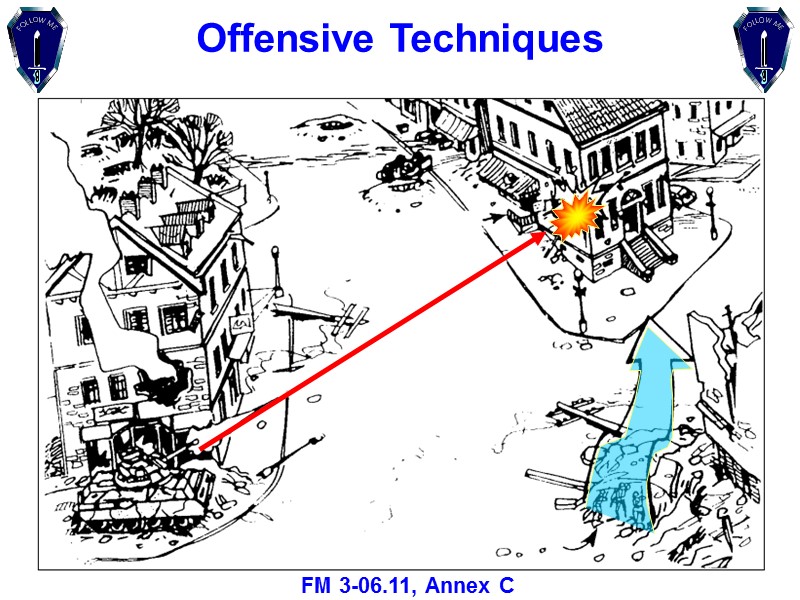
Offensive Techniques FM 3-06.11, Annex C
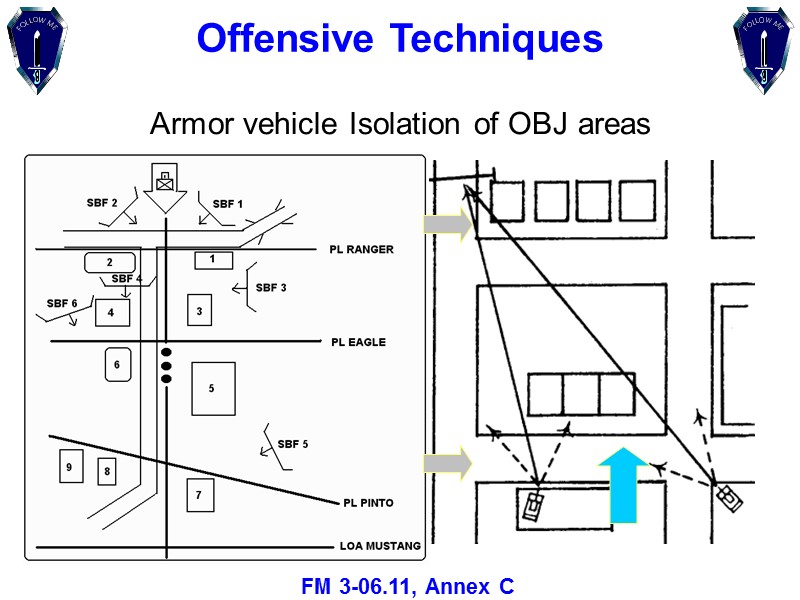
Armor vehicle Isolation of OBJ areas Offensive Techniques FM 3-06.11, Annex C
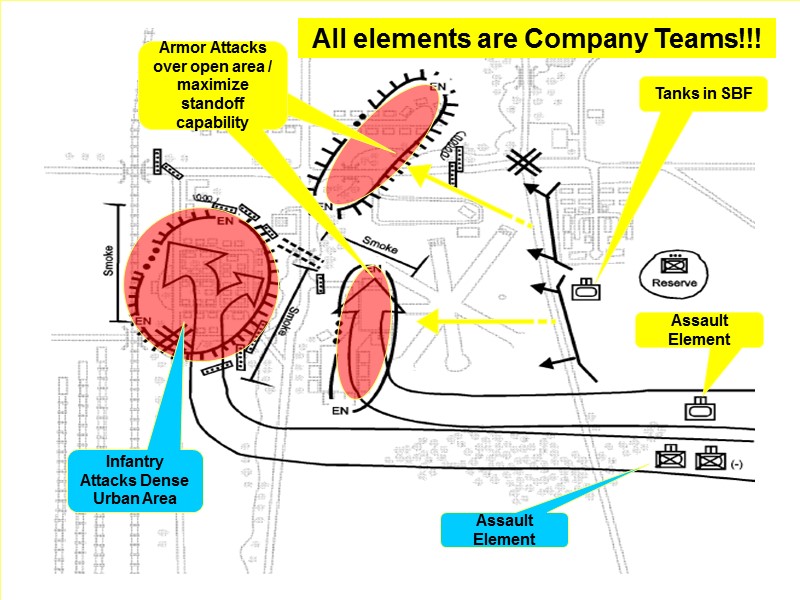
Offensive Operations Assault Element All elements are Company Teams!!!
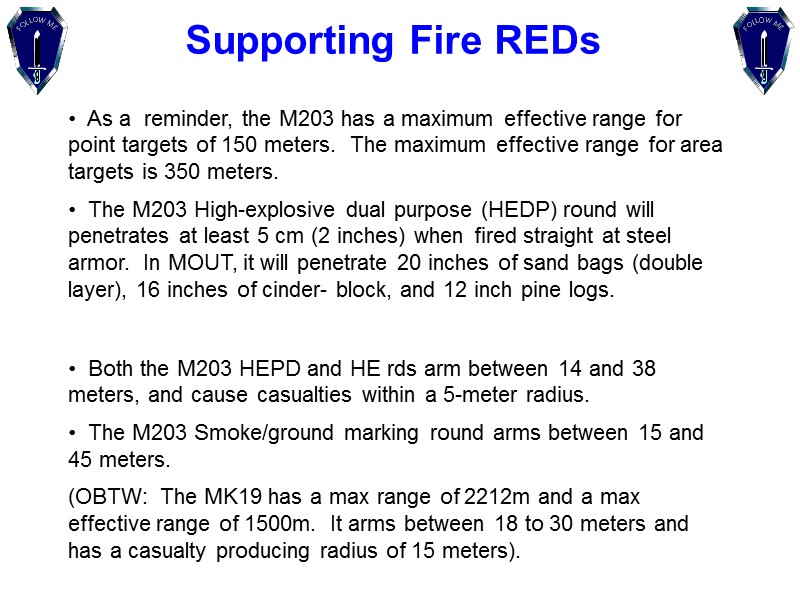
As a reminder, the M203 has a maximum effective range for point targets of 150 meters. The maximum effective range for area targets is 350 meters. The M203 High-explosive dual purpose (HEDP) round will penetrates at least 5 cm (2 inches) when fired straight at steel armor. In MOUT, it will penetrate 20 inches of sand bags (double layer), 16 inches of cinder- block, and 12 inch pine logs. Supporting Fire REDs Both the M203 HEPD and HE rds arm between 14 and 38 meters, and cause casualties within a 5-meter radius. The M203 Smoke/ground marking round arms between 15 and 45 meters. (OBTW: The MK19 has a max range of 2212m and a max effective range of 1500m. It arms between 18 to 30 meters and has a casualty producing radius of 15 meters).
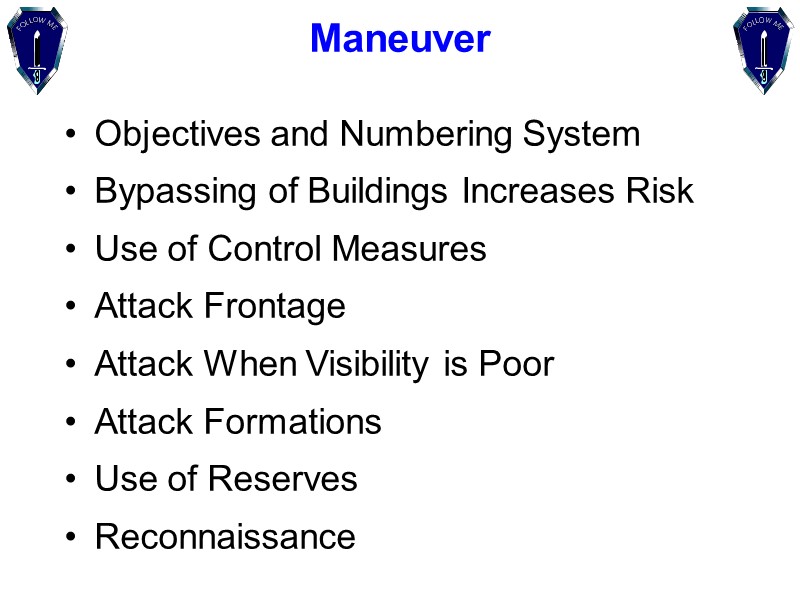
Objectives and Numbering System Bypassing of Buildings Increases Risk Use of Control Measures Attack Frontage Attack When Visibility is Poor Attack Formations Use of Reserves Reconnaissance Maneuver
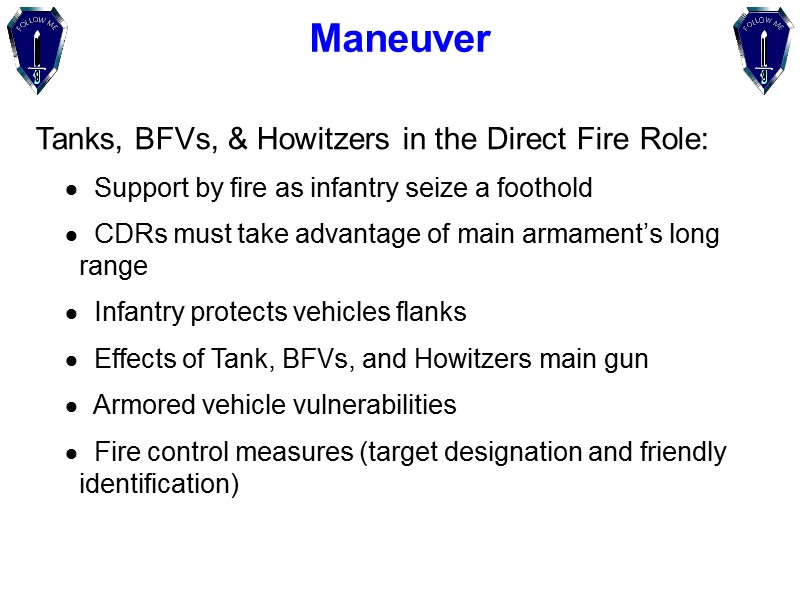
Tanks, BFVs, & Howitzers in the Direct Fire Role: Support by fire as infantry seize a foothold CDRs must take advantage of main armament’s long range Infantry protects vehicles flanks Effects of Tank, BFVs, and Howitzers main gun Armored vehicle vulnerabilities Fire control measures (target designation and friendly identification) Maneuver
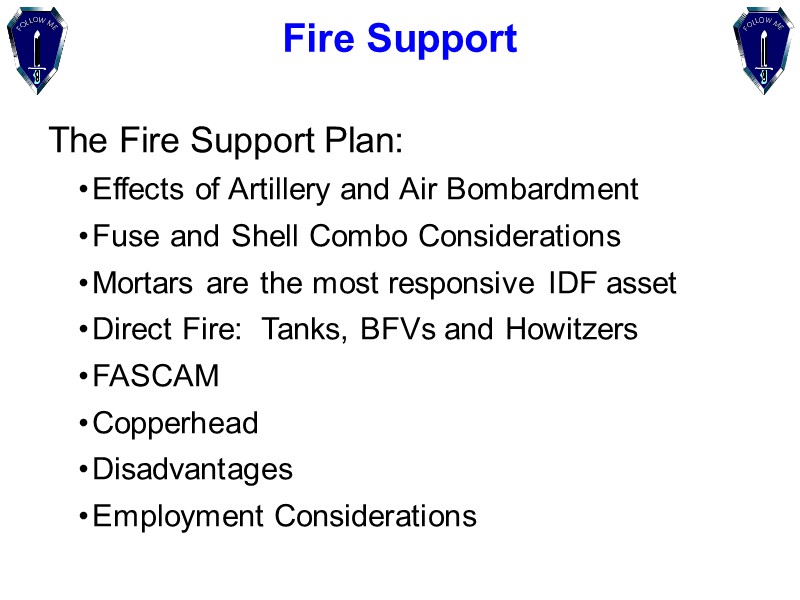
The Fire Support Plan: Effects of Artillery and Air Bombardment Fuse and Shell Combo Considerations Mortars are the most responsive IDF asset Direct Fire: Tanks, BFVs and Howitzers FASCAM Copperhead Disadvantages Employment Considerations Fire Support
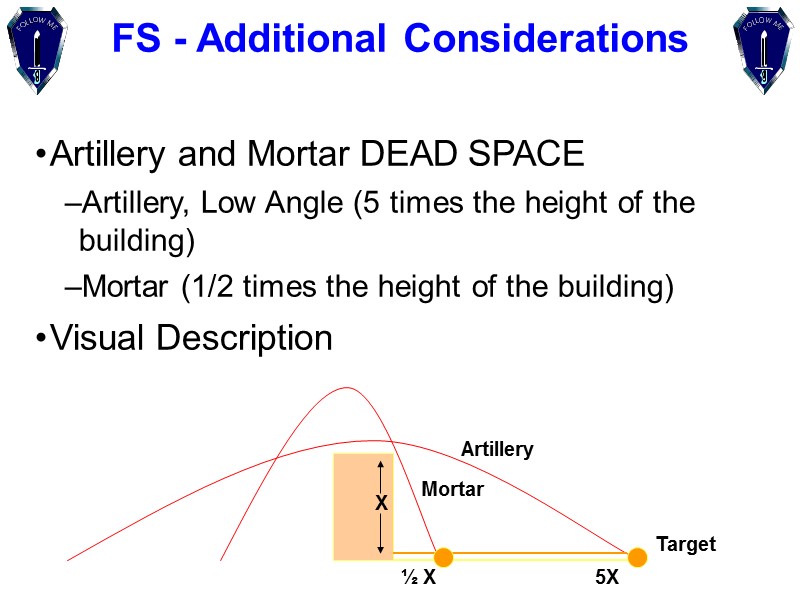
Artillery and Mortar DEAD SPACE Artillery, Low Angle (5 times the height of the building) Mortar (1/2 times the height of the building) Visual Description FS - Additional Considerations X 5X ½ X Mortar Artillery Target
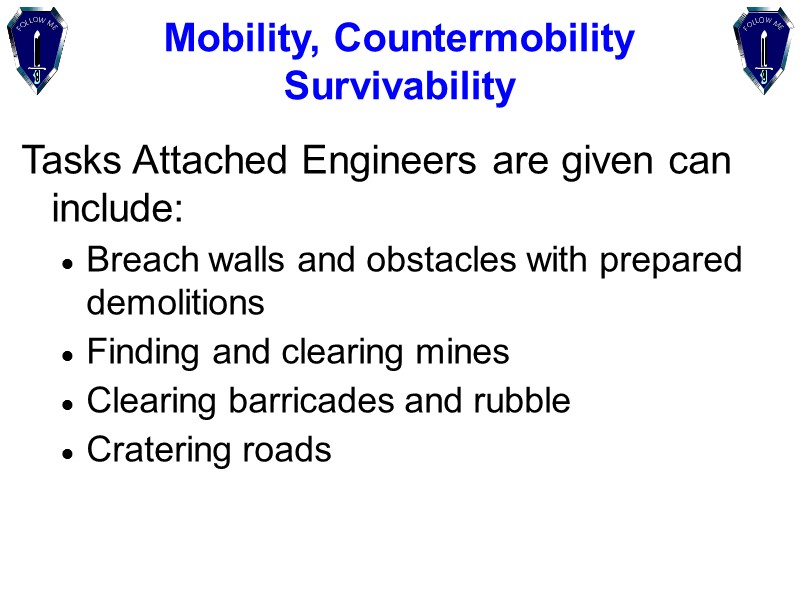
Tasks Attached Engineers are given can include: Breach walls and obstacles with prepared demolitions Finding and clearing mines Clearing barricades and rubble Cratering roads Mobility, Countermobility Survivability
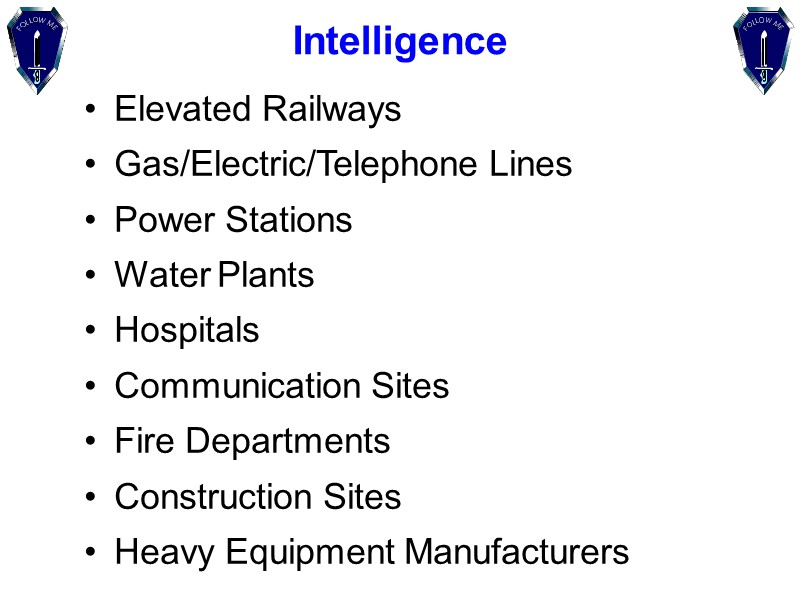
Intelligence Elevated Railways Gas/Electric/Telephone Lines Power Stations Water Plants Hospitals Communication Sites Fire Departments Construction Sites Heavy Equipment Manufacturers
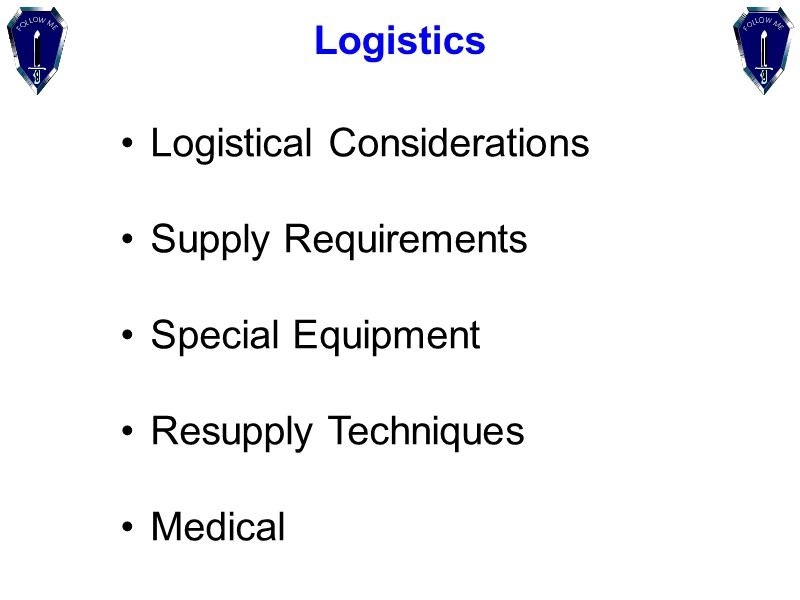
Logistics Logistical Considerations Supply Requirements Special Equipment Resupply Techniques Medical
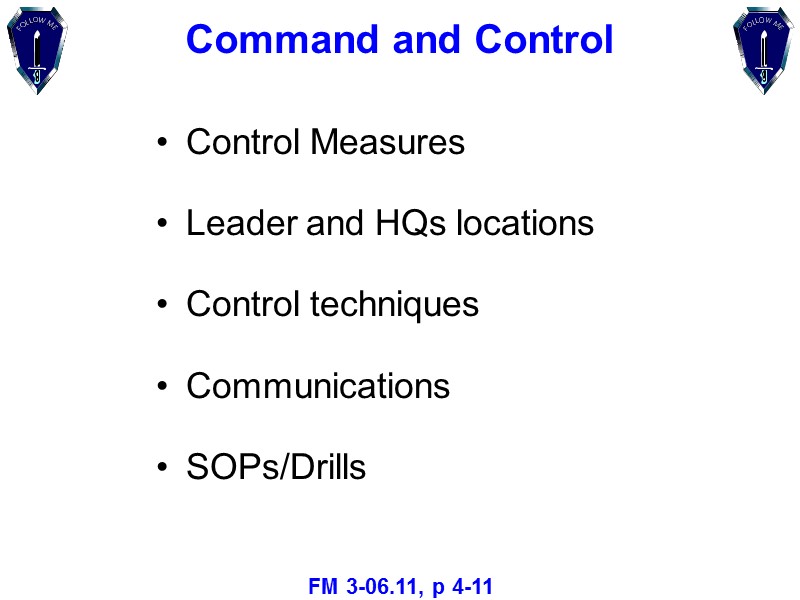
Command and Control Control Measures Leader and HQs locations Control techniques Communications SOPs/Drills FM 3-06.11, p 4-11
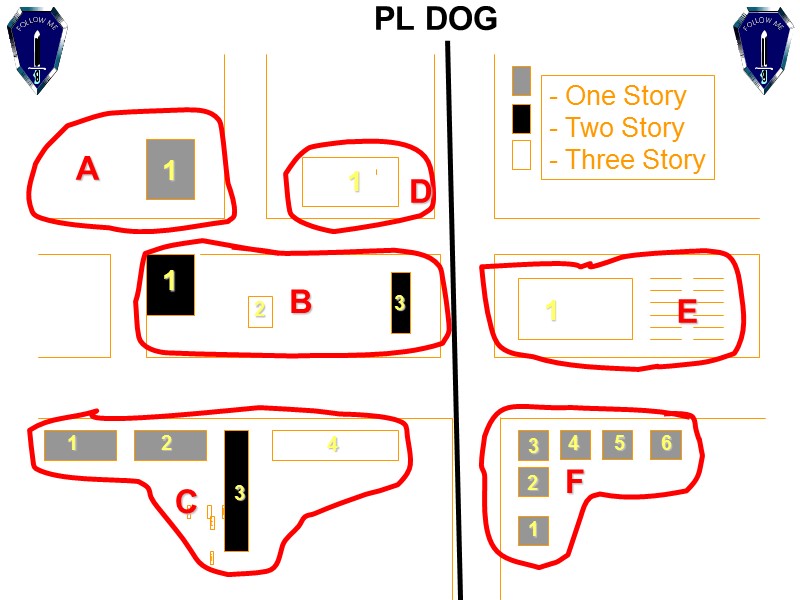
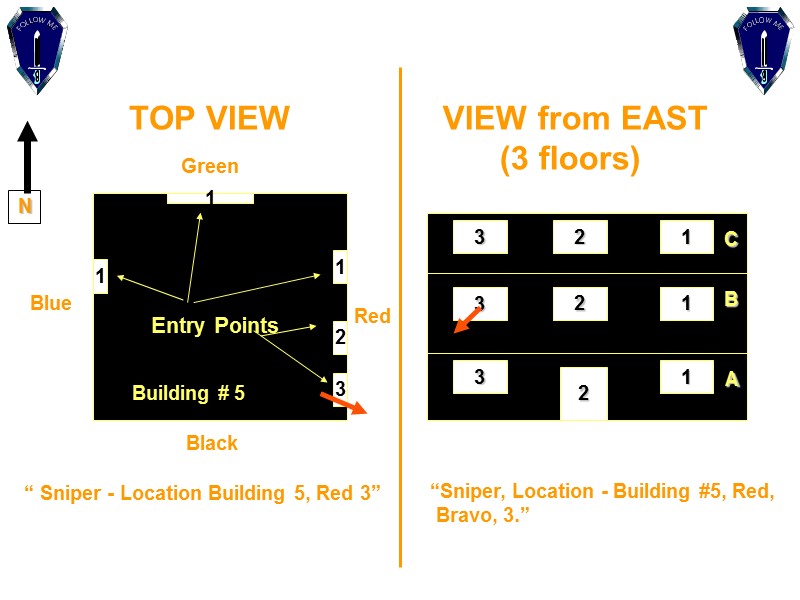
3 TOP VIEW Green Blue Red Black Building # 5 “ Sniper - Location Building 5, Red 3” VIEW from EAST (3 floors) 3 1 2 3 2 1 A B C “Sniper, Location - Building #5, Red, Bravo, 3.” 2 1 3
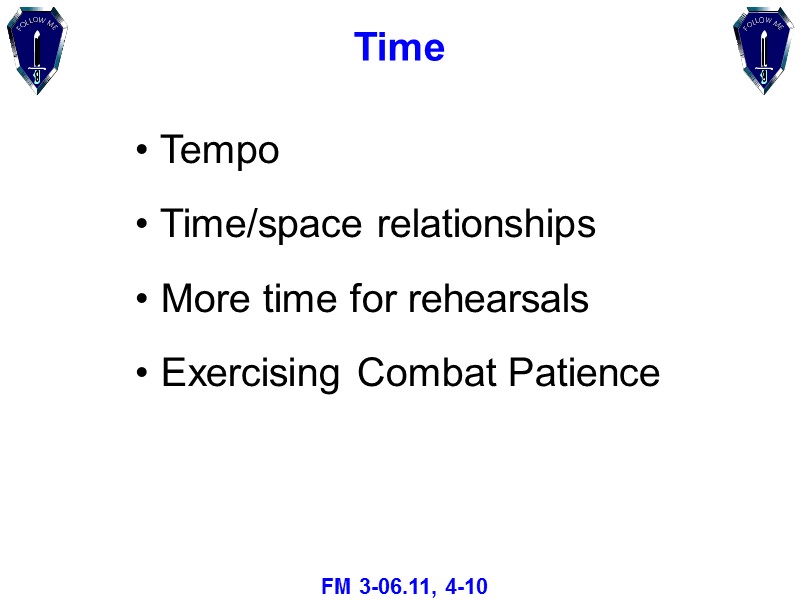
Time Tempo Time/space relationships More time for rehearsals Exercising Combat Patience FM 3-06.11, 4-10
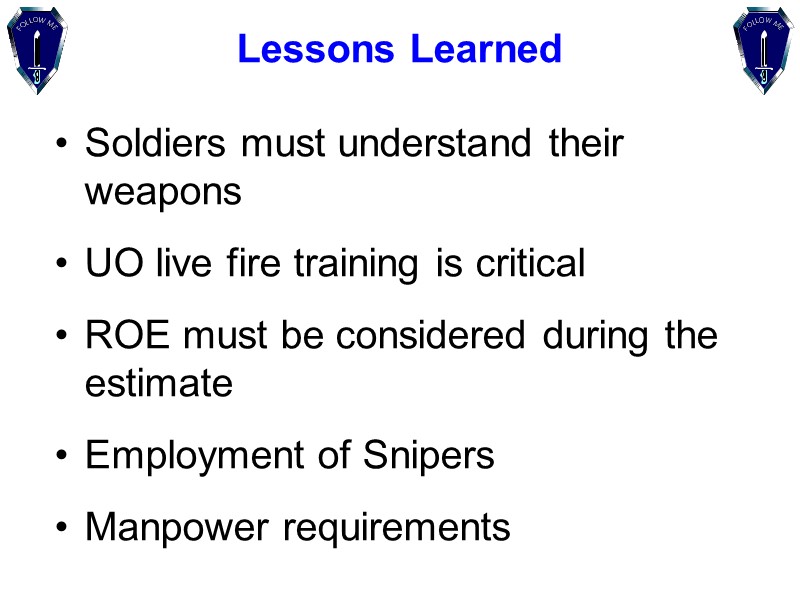
Lessons Learned Soldiers must understand their weapons UO live fire training is critical ROE must be considered during the estimate Employment of Snipers Manpower requirements
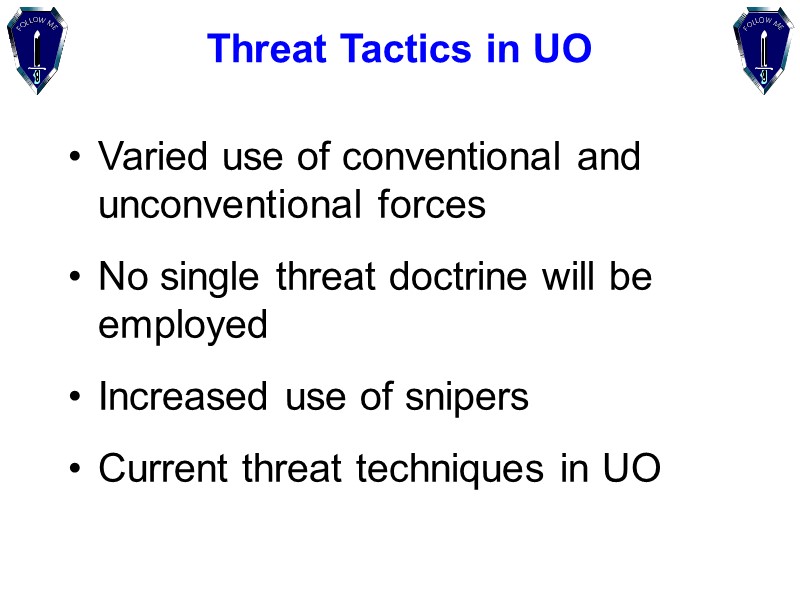
Threat Tactics in UO Varied use of conventional and unconventional forces No single threat doctrine will be employed Increased use of snipers Current threat techniques in UO
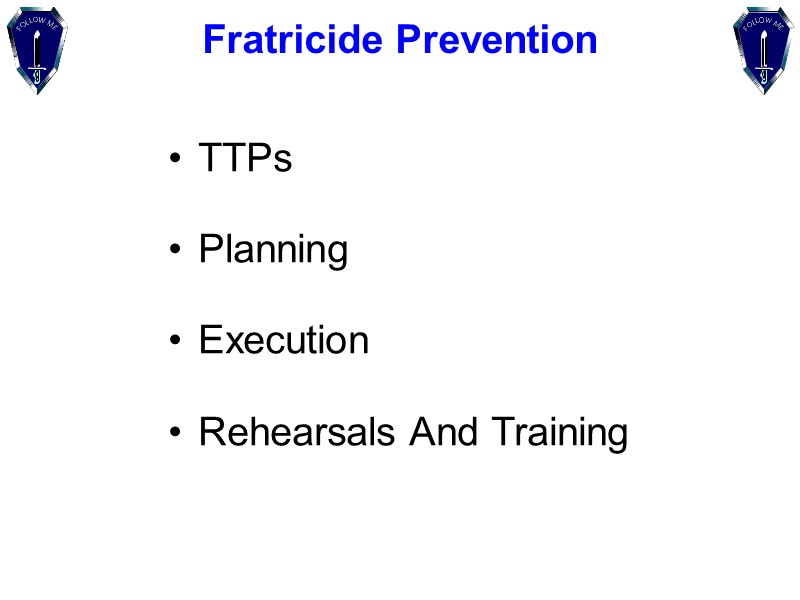
TTPs Planning Execution Rehearsals And Training Fratricide Prevention
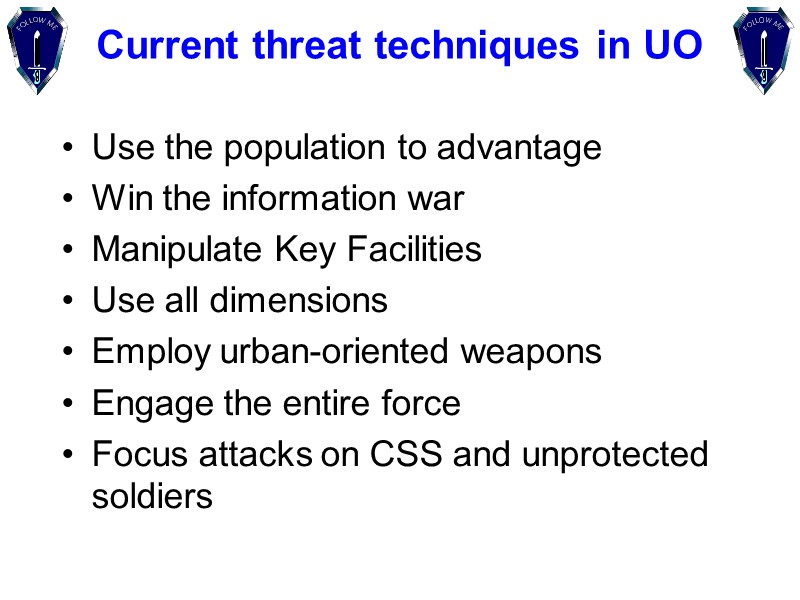
Current threat techniques in UO Use the population to advantage Win the information war Manipulate Key Facilities Use all dimensions Employ urban-oriented weapons Engage the entire force Focus attacks on CSS and unprotected soldiers
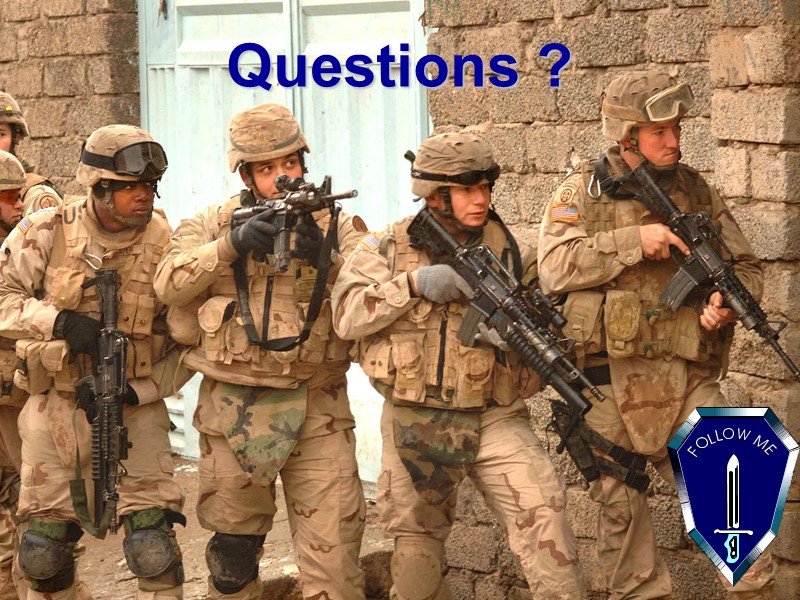
Questions ?
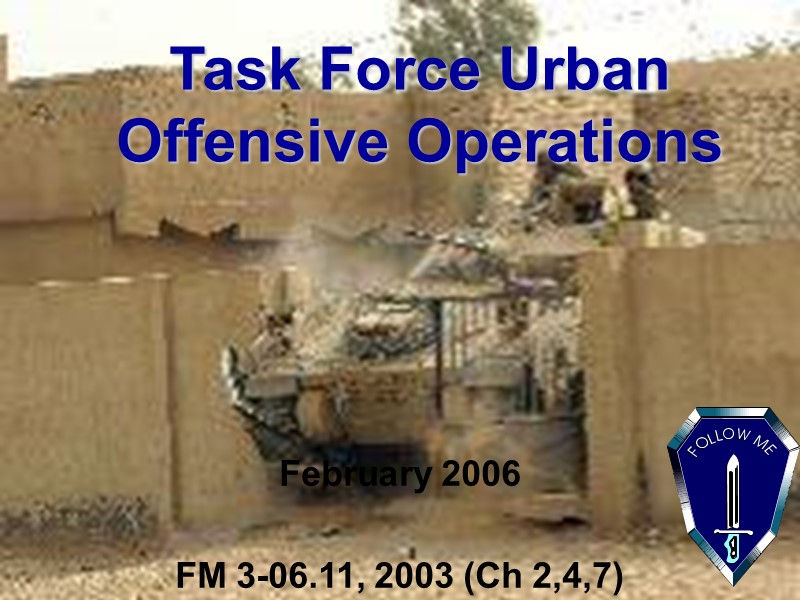
Task Force Urban Offensive Operations February 2006 FM 3-06.11, 2003 (Ch 2,4,7)
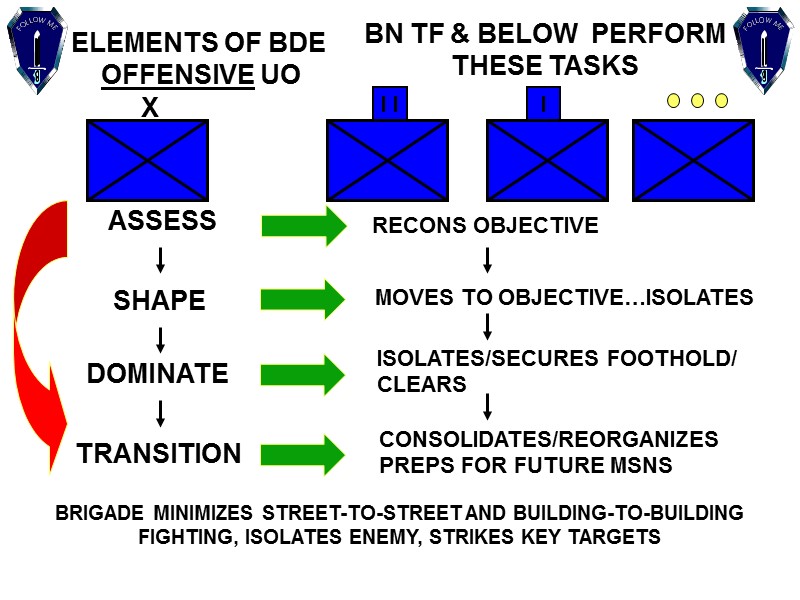
ISOLATES/SECURES FOOTHOLD/ CLEARS I I I I I I SHAPE DOMINATE TRANSITION MOVES TO OBJECTIVE…ISOLATES CONSOLIDATES/REORGANIZES PREPS FOR FUTURE MSNS BRIGADE MINIMIZES STREET-TO-STREET AND BUILDING-TO-BUILDING FIGHTING, ISOLATES ENEMY, STRIKES KEY TARGETS BN TF & BELOW PERFORM THESE TASKS X ASSESS RECONS OBJECTIVE ELEMENTS OF BDE OFFENSIVE UO
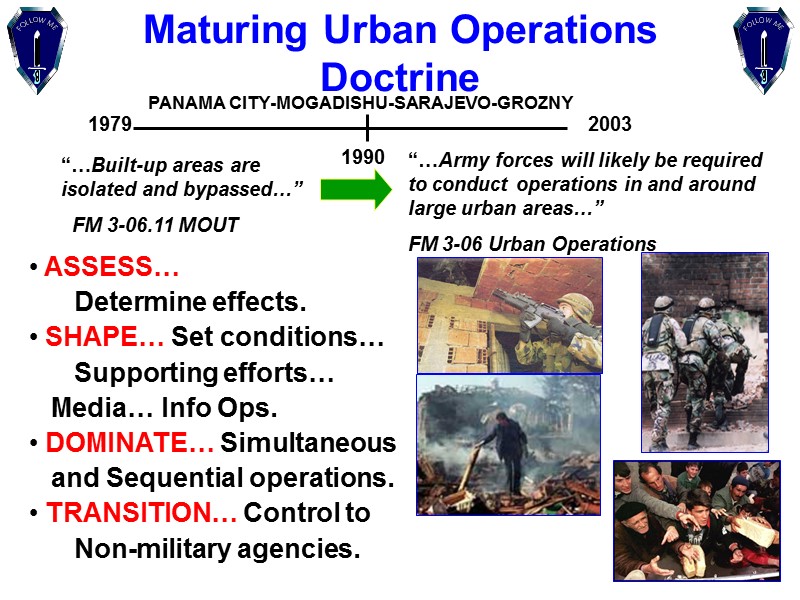
Maturing Urban Operations Doctrine ASSESS… Determine effects. SHAPE… Set conditions… Supporting efforts… Media… Info Ops. DOMINATE… Simultaneous and Sequential operations. TRANSITION… Control to Non-military agencies.
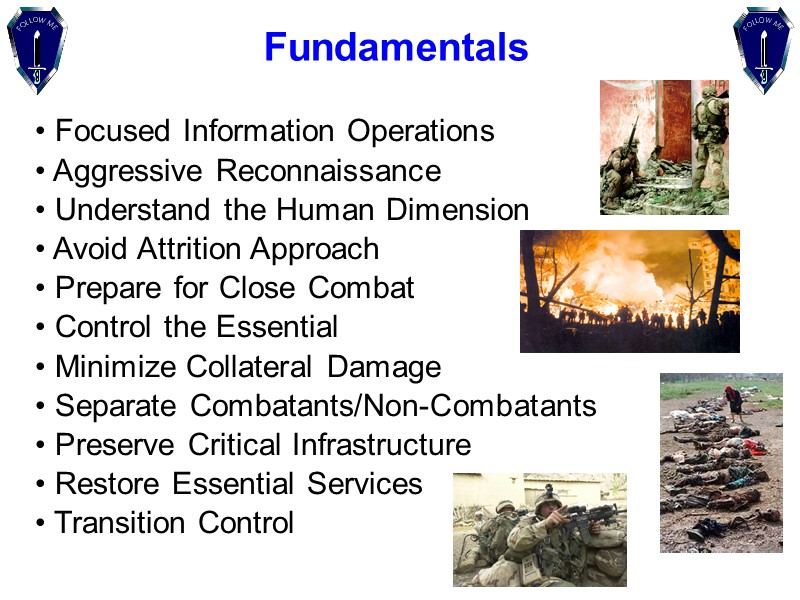
Fundamentals Focused Information Operations Aggressive Reconnaissance Understand the Human Dimension Avoid Attrition Approach Prepare for Close Combat Control the Essential Minimize Collateral Damage Separate Combatants/Non-Combatants Preserve Critical Infrastructure Restore Essential Services Transition Control
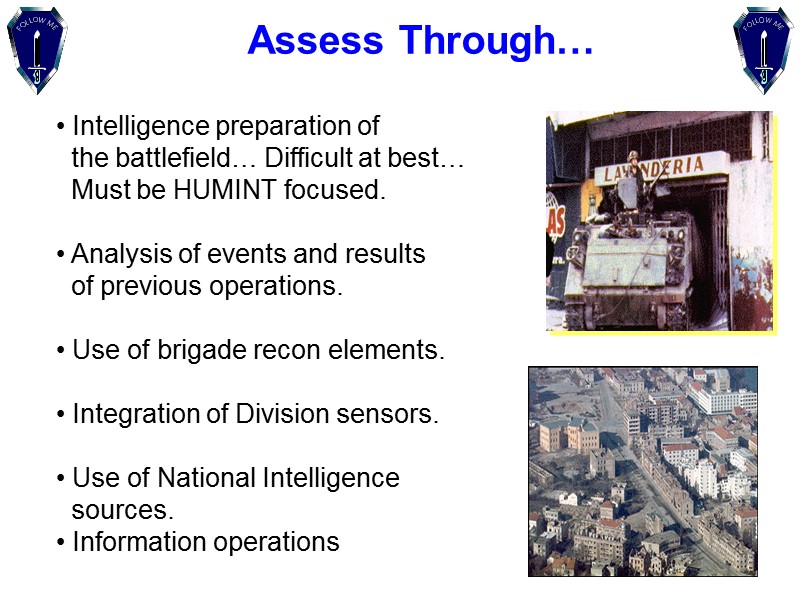
Assess Through… Intelligence preparation of the battlefield… Difficult at best… Must be HUMINT focused. Analysis of events and results of previous operations. Use of brigade recon elements. Integration of Division sensors. Use of National Intelligence sources. Information operations
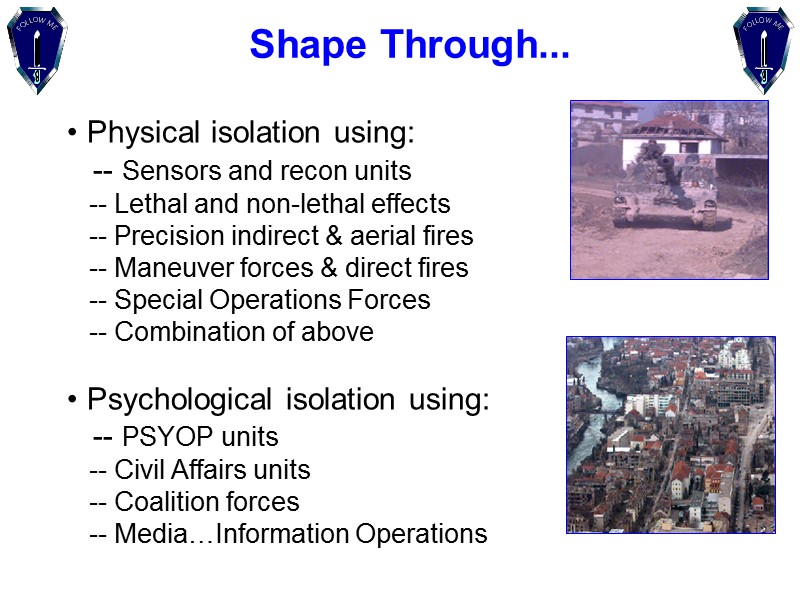
Shape Through... Physical isolation using: -- Sensors and recon units -- Lethal and non-lethal effects -- Precision indirect & aerial fires -- Maneuver forces & direct fires -- Special Operations Forces -- Combination of above Psychological isolation using: -- PSYOP units -- Civil Affairs units -- Coalition forces -- Media…Information Operations
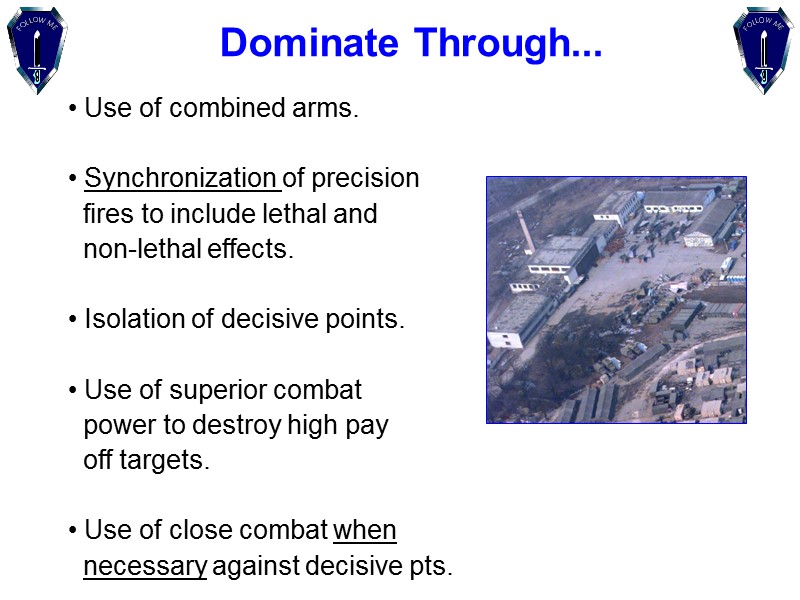
Dominate Through... Use of combined arms. Synchronization of precision fires to include lethal and non-lethal effects. Isolation of decisive points. Use of superior combat power to destroy high pay off targets. Use of close combat when necessary against decisive pts.
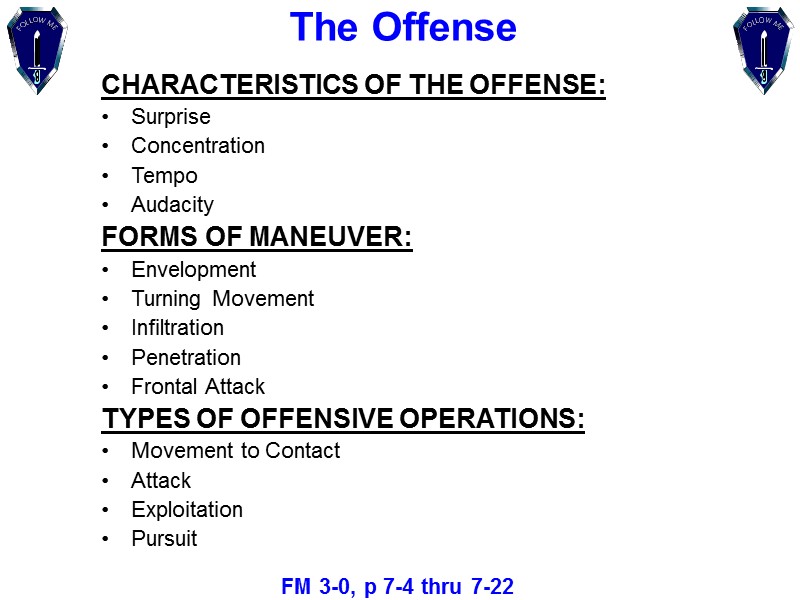
The Offense CHARACTERISTICS OF THE OFFENSE: Surprise Concentration Tempo Audacity FORMS OF MANEUVER: Envelopment Turning Movement Infiltration Penetration Frontal Attack TYPES OF OFFENSIVE OPERATIONS: Movement to Contact Attack Exploitation Pursuit FM 3-0, p 7-4 thru 7-22
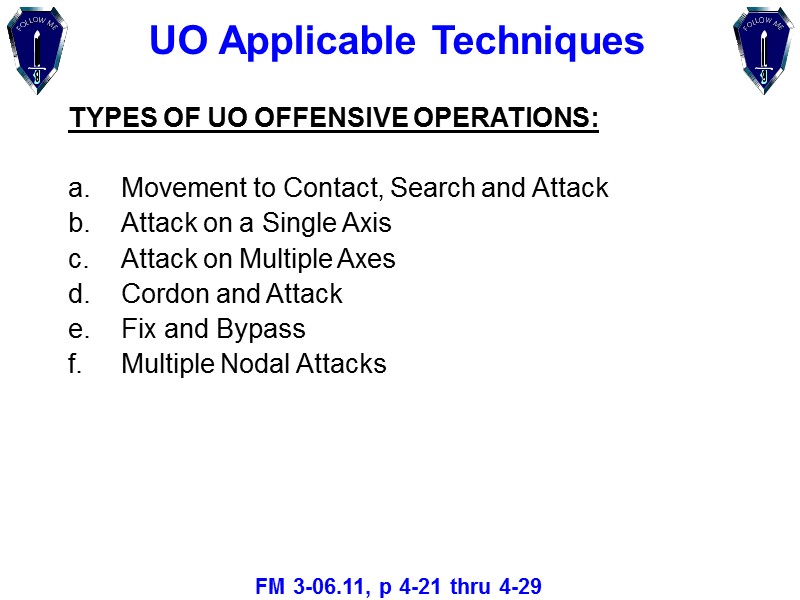
UO Applicable Techniques TYPES OF UO OFFENSIVE OPERATIONS: Movement to Contact, Search and Attack Attack on a Single Axis Attack on Multiple Axes Cordon and Attack Fix and Bypass Multiple Nodal Attacks FM 3-06.11, p 4-21 thru 4-29
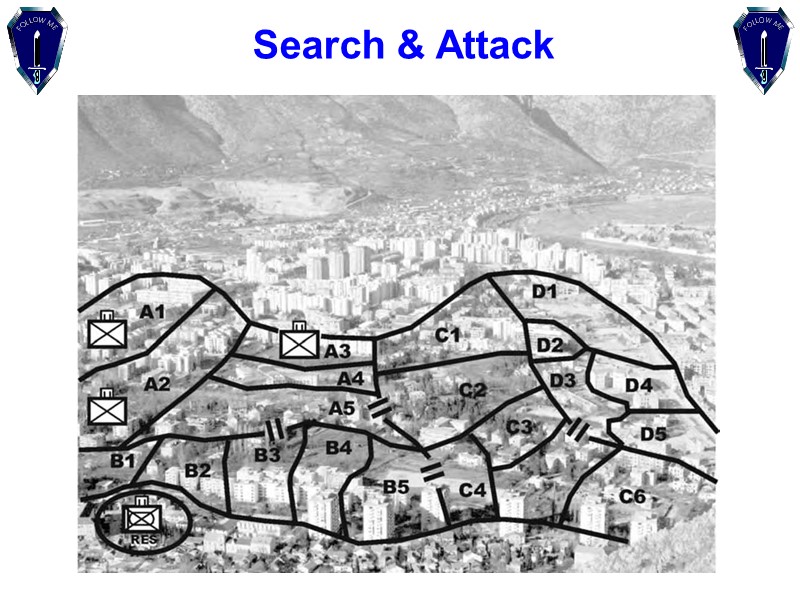
Search & Attack
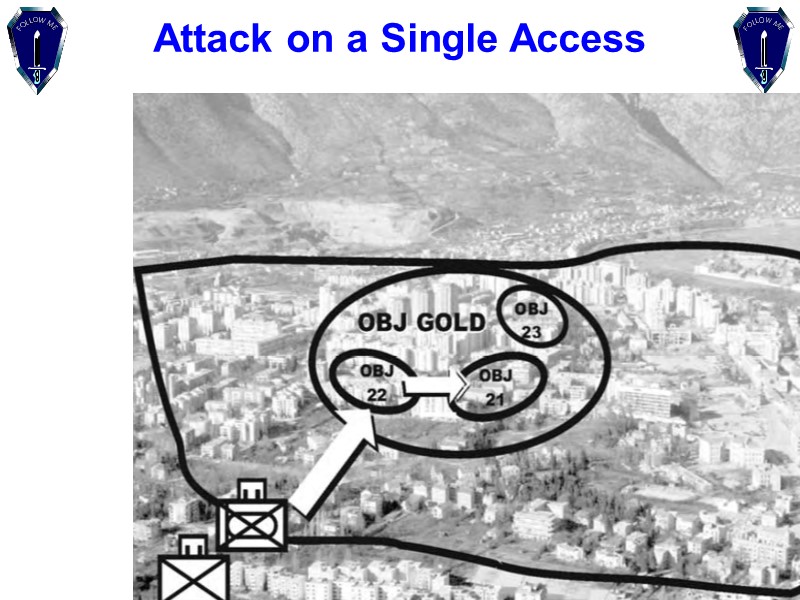
Attack on a Single Access
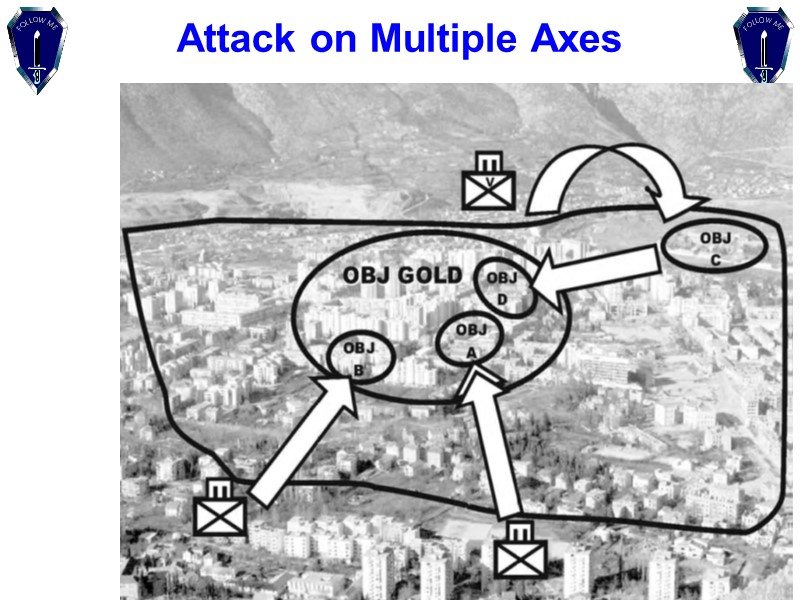
Attack on Multiple Axes
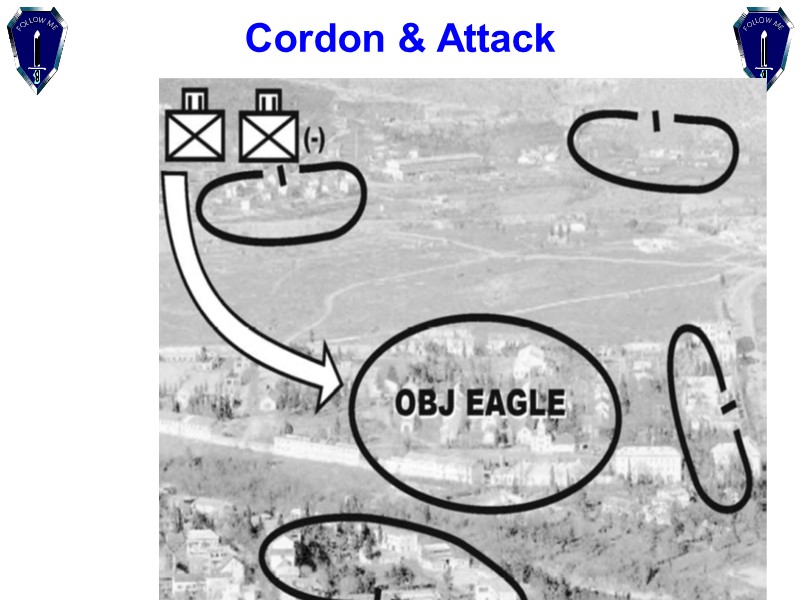
Cordon & Attack
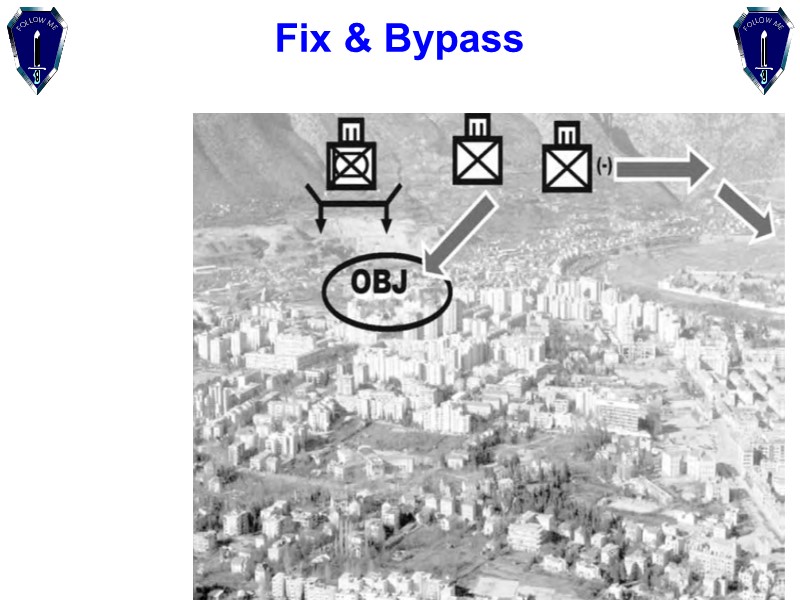
Fix & Bypass
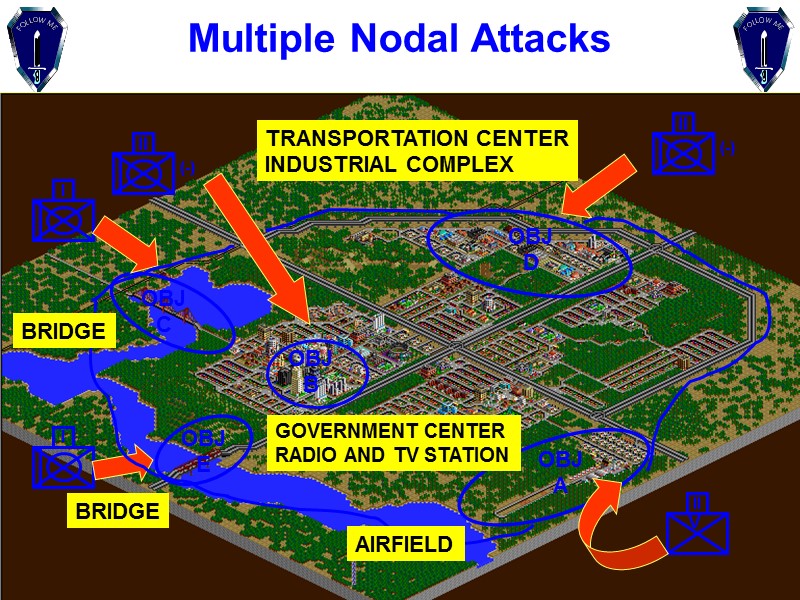
OBJ A OBJ B GOVERNMENT CENTER RADIO AND TV STATION OBJ C OBJ D TRANSPORTATION CENTER INDUSTRIAL COMPLEX OBJ E BRIDGE AIRFIELD BRIDGE Multiple Nodal Attacks
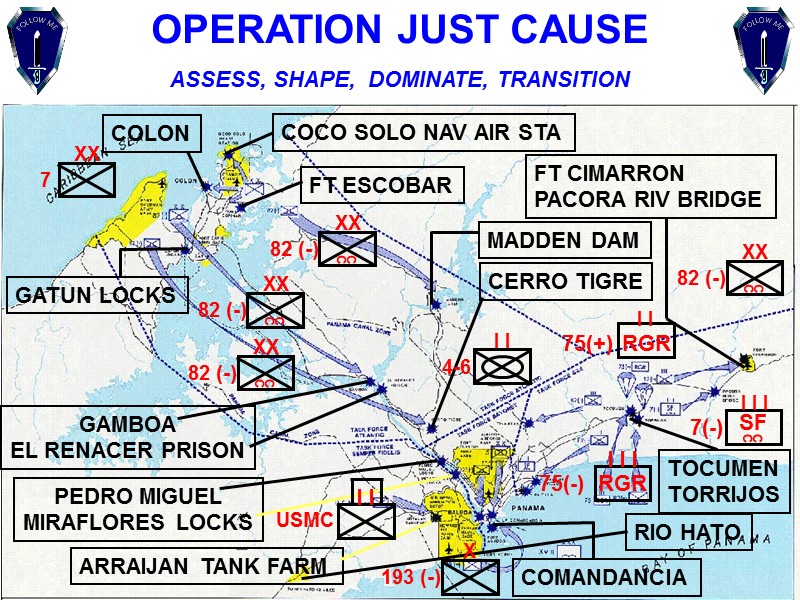
OPERATION JUST CAUSE ASSESS, SHAPE, DOMINATE, TRANSITION
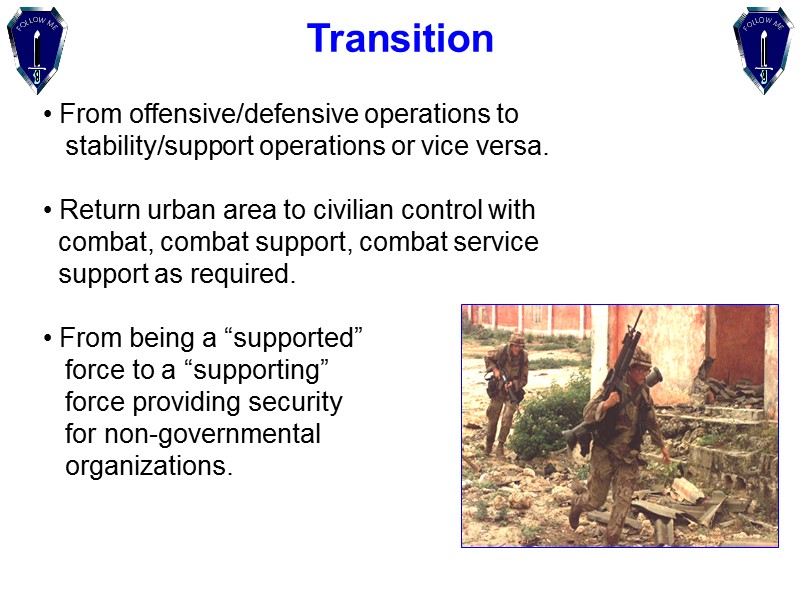
From offensive/defensive operations to stability/support operations or vice versa. Return urban area to civilian control with combat, combat support, combat service support as required. From being a “supported” force to a “supporting” force providing security for non-governmental organizations. Transition
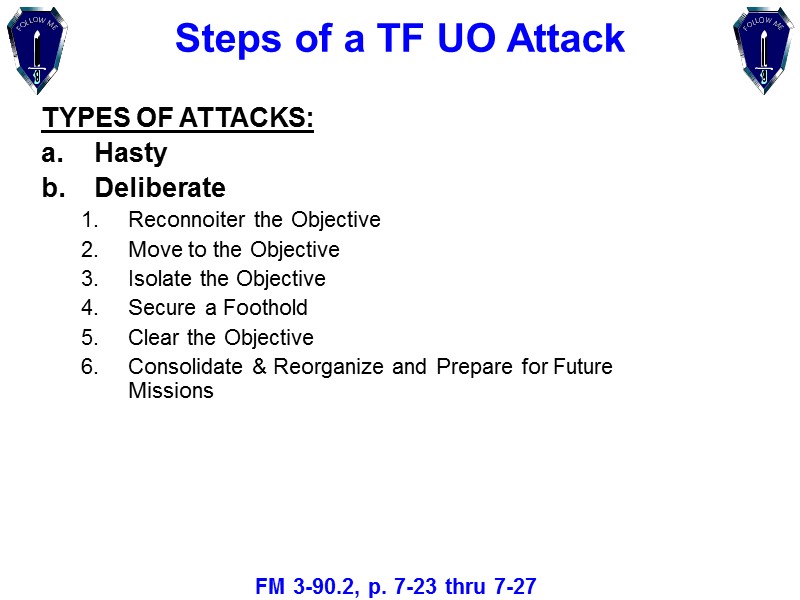
TYPES OF ATTACKS: Hasty Deliberate Reconnoiter the Objective Move to the Objective Isolate the Objective Secure a Foothold Clear the Objective Consolidate & Reorganize and Prepare for Future Missions FM 3-90.2, p. 7-23 thru 7-27 Steps of a TF UO Attack
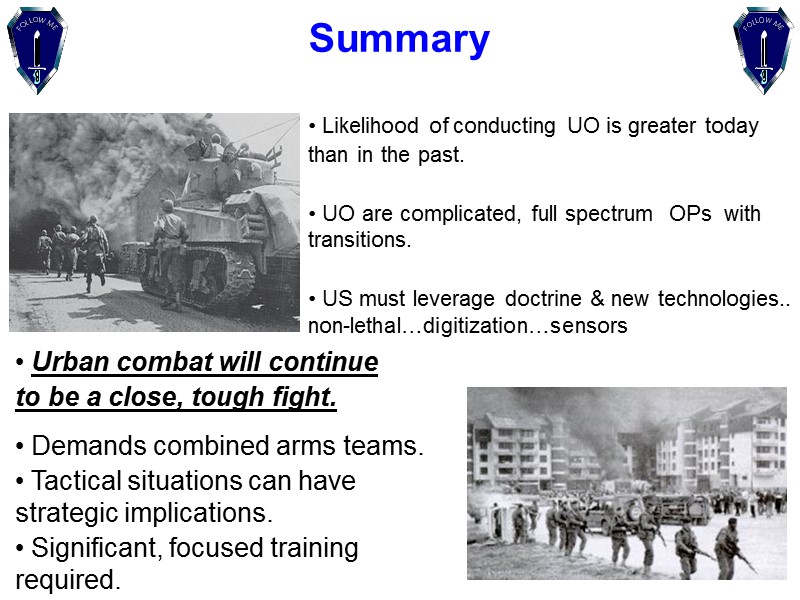
Urban combat will continue to be a close, tough fight. Demands combined arms teams. Tactical situations can have strategic implications. Significant, focused training required. Likelihood of conducting UO is greater today than in the past. UO are complicated, full spectrum OPs with transitions. US must leverage doctrine & new technologies.. non-lethal…digitization…sensors Summary
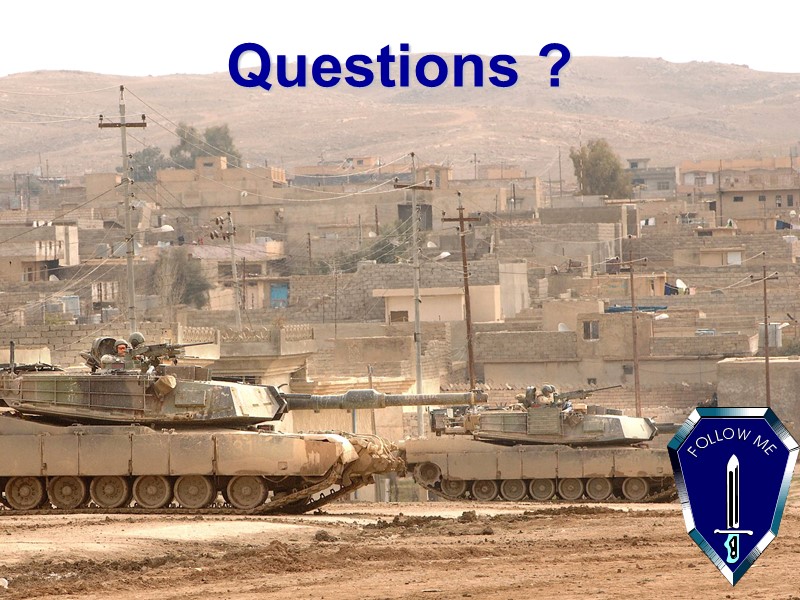
Questions ?
28968-company_urban_offensive_operations_mar_06.ppt
- Количество слайдов: 90

